A Story of High Adventure and Reincarnation
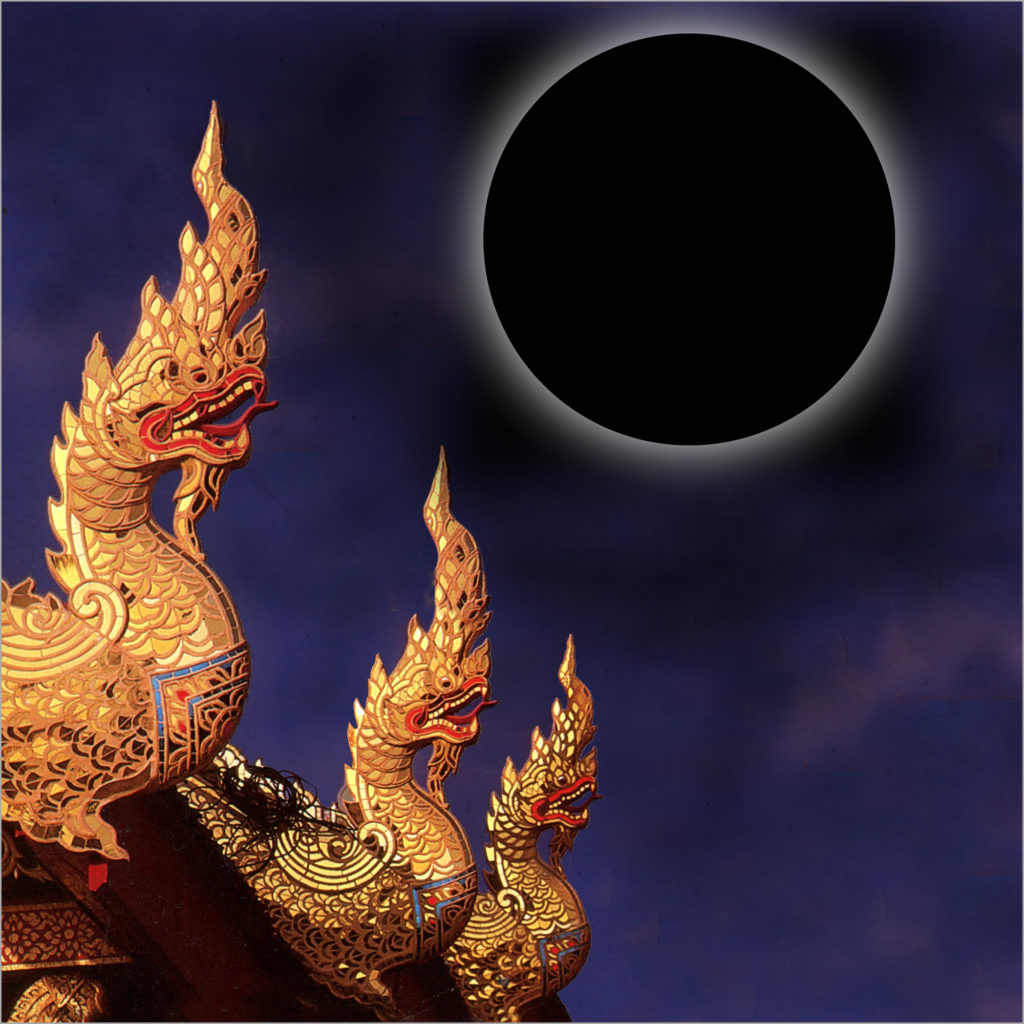
by
John Bonath
FROZEN DREAM
by Shel Silverstein
I’ll take the dream I had last night
And put it in my freezer,
So someday long and far away
When I’m an old gray geezer,
I’ll take it out and thaw it out,
This lovely dream I’ve frozen,
And boil it up and sit me down
A dip my old cold toes in.
Prologue
Many read my stories and may assume there is fiction in the mix. I can only say that my approach to writing relies on that which is remembered. Experiences that are stranger than fantasy are the cards I have been dealt and the way they have played out; tales from a thirsty experience monger, diving for inspiration in the vast, cavernous wells of life.
We all have stories that never get shared – stories, perhaps of trauma, perhaps of wonder. Private stories, kept silent, that haunt our dreams and go to the tomb with us; such are songs we write but never sing. Yet these silent songs empower us. They exist in some cosmic history like the Akashic Records (a vibratory compendium of all universal events, thoughts, words, emotions, and intent ever to have occurred in the past, present, and future in terms of all life forms). Such is the source of this story, dredged out of an old memory, to dip my old, cold toes in… and with this blog, written with a life of its own to share with you.
1
Some may say it is imagination but I say not. My senses are intact with a memory of an image as sharp as a photograph; a vision clear as day that puts all question out of mind. Such is an image that I surmise manifested in my brain prior to birth; composed of visual elements that were not to be found growing up in the world of a small Ohio township during the 1950’s and 1960’s – a vivid image embedded from within, with a mystery which haunts my memory beyond a present lifetime.
The still, singular picture frame does not change. Like the perception of any picture, there is a sequence to taking it in. The first thing of note is a man lying face up before me. His head is shaved, he is wrapped in an orange cloth, his hands rest folded on his abdomen, his eyes are closed as if in a deep sleep, and I am very aware that he is no longer alive. My heart gives full attention to this man with feelings of a love so deep, with a sorrow to match. Gazing up, I notice there are others present. I am but a link in a surrounding circle of men. The others all have shaved heads and are also draped in orange cloth. I realize that I too, look like everyone else. The man was a revered teacher, and we were his disciples. This simple image is as I remember it. In my younger years, I had no understanding of who these men were; there was no intellectual understanding of any kind, only the strong sensation felt from it. I had never seen anyone who looked like this, nor had I any idea of any culture other than what composed my little world growing up in the Midwest countryside. I never mentioned it to anyone. How could I? It made no sense in my present context. It was a private memory, noted without placing any great relevance to it, but never forgotten.
Much later in junior high school, I ran across a book on yoga in an eclectic mail-order catalog. The subject was one that I was intensely curious about but at that time and place, a subject that was difficult to find any information about. It seems strange to look back, but in the mid-sixties, there were no such things as yoga classes, the Internet was still science fiction, and there was not a single book on yoga in either the public library or our meager school library. I ordered the book. When it arrived in our rural mailbox, with my name on it, I eagerly took it up to my bedroom, closed the door, and opened my exotic package. The book had a hard, blue cover, smelled musty, and was illustrated with peculiar black and white photographs of a very skinny Indian yogi who wore a skimpy loincloth and long white hair piled high on his head. The esoteric writings were of radical practices found in traditional Indian yoga. I still remember a photo sequence of a sinus cleansing technique where he put a long cloth through one nostril and out his mouth, then pulled it back and forth. Many of the poses were impossible for a novice like myself but I managed quite a few of them and experimented with the meditation exercises. This book formed the genesis of my yoga practice.
A couple years later, I read the Herman Hesse novel Siddhartha (about a young prince in India who later became known as the Buddha). The imagery that this story conjured up was the closest explanation I had come across yet of the orange-robed people in my vision. These two books were germinal to the concept that perhaps I had been an Indian monk in a previous life. It was an interesting notion to fantasize about.
In high school I embarked on reading more about Buddhism. I had an uncanny and natural understanding of this religion – it was the way I innately understood life to be. My personal belief system was never in line with the Presbyterian Church of my parents, or any other Christian religion I came across. This was a major source of frustration for my father. One day, when I was in junior high school, he sat me down for a father-son talk. He proclaimed that he had done all he could to raise me in his Christian footsteps and that he was giving up. He formally relinquished himself of his parental Christian duty and told me the responsibility for my lost soul was no longer his burden. I felt bad about him viewing it as his failure but was relieved to have my own choices in the matter.
From early childhood, ideas about life that conformed to Buddhism came from deep within. When I was eighteen, I became part of a Zen Buddhist group in Cleveland. It was a difficult practice but one that I took to without reserve and have followed to this day. It wasn’t as if I were converted to a religion, rather it was like running across organized writing that summed up my natural perspective on life. Zen Buddhist concepts and attitude epitomized that which I independently believed about the nature of things.
In America during the late sixties, the “East/West” connection was strong. Yoga, meditation, and all things non-Western flooded the American culture and flourished. There were many books and magazines on Buddhism in which I ran across photographs of Tibetan Buddhist monks for the first time. They wore orange cloths and looked more like the monks in my memory than pictures of Indian monks that I was more familiar with. My thoughts on where this private image may have taken place shifted from India to Tibet. Through my early thirties, I carried the belief that the monks in my picture were Tibetan.
2
Fast forward eighteen years to the year 1989. After having lived a year in Kyoto, Japan, my Japanese visa was expiring. A new in job in Tanabe, Japan was three months out and during this time, I was left with a three-month visa gap. One option was to fly to Korea and return on a “tourist visa” until my new “job visa” took effect. But this was not financially viable. So with health waning, I spent a month at a US health retreat to get back on my feet, and then based myself in Thailand for the remaining two months in order to stretch out what little money I had, before returning to Japan to start a new life.
At that point in history, Thailand had the reputation of being an undiscovered paradise for free-spirited young travelers, jet setters, and hippies. The early Leonardo Decaprio film The Beach portrays this era of the hip invasion into Thailand and its subsequent fade from history. One could travel and eat banquets of Thai dishes with fresh shrimp and hand-shelled crab for $10 a day. Two of my best friends in Japan were from Thailand. One offered a place to stay with his family in Bangkok, which came with a family-owned crocodile farm. It all made for a good territory to hang out in and explore until my new job in Japan started up.
In 1989, Thailand was one of the safest countries in Southeast Asia. Its monarchy was still in existence, giving it a very different history than the surrounding countries which were ruled by military regimes. The Thai people still revered their king back then and his picture hung in everyone’s homes and businesses. Thailand’s governing monarchy provided relative stability and isolation from the turmoil that existed all around. The Vietnam war was over but the repercussions that followed throughout Southeast Asia were immense.
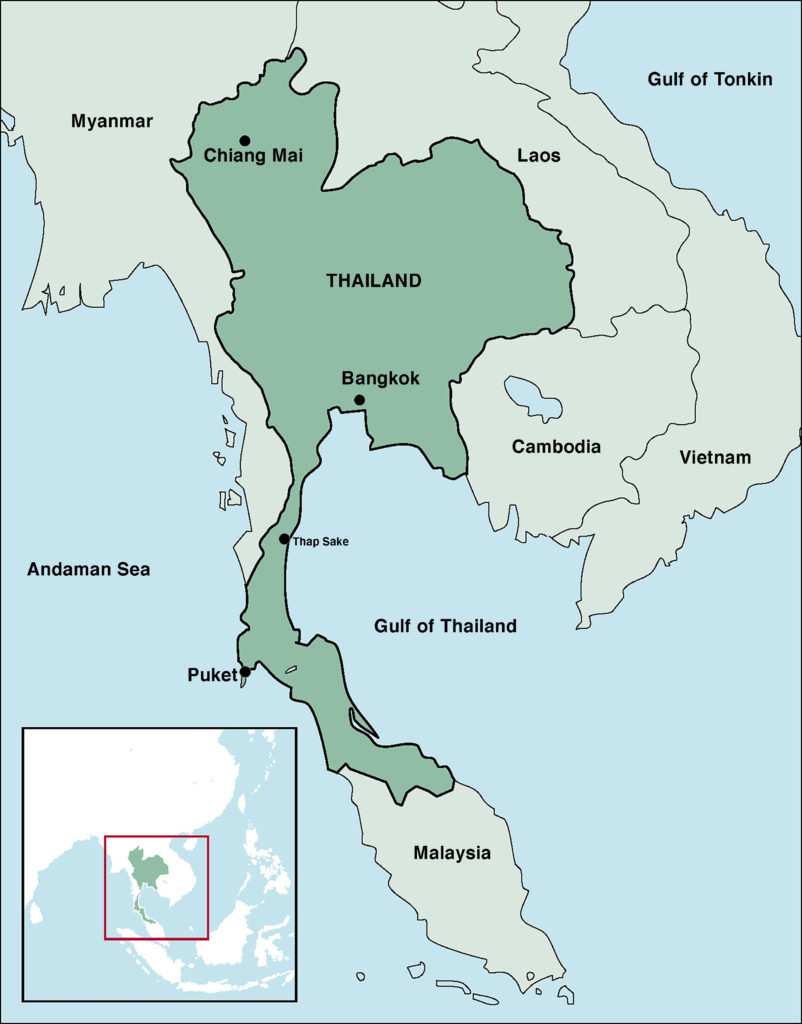
To Thailand’s south lies Cambodia (Kampuchea). Just ten years earlier, in 1979, the Vietnamese invaded Cambodia and overthrew the Khmer Rouge (the Communist party of Kampuchea). During the four years prior to the overthrow of the Khmer Rouge was the blood curdling history of The Killing Fields, where the Khmer Rouge mercilessly massacred more than a million civilians. After the Vietnamese invasion, Vietnam created a Cambodian government and ruled the country for the next 12 years. During this time, the Khmer Rouge fought a guerrilla war against the Vietnamese occupiers and the Cambodian government. The chaos caused hundreds of thousands of Cambodians to rush the Thai border escaping violence and famine.
When I was in Thailand, this catastrophe was the worst humanitarian disaster in the world. In the early 1990’s, the final phase of the Cambodian crisis reached a resolution when Vietnam withdrew from the country and The United Nations led Cambodia toward an elected government and repatriated 360,000 Cambodians. The refugee camps were emptied and shut down with about 260,000 of the refugees being resettled abroad, more than one-half of them in the United States.
To the West of Thailand lies Myanmar, also known as Burma. Until 1999, Myanmar was ruled by the longest-running military dictatorship in the world. In 1988, there was a nationwide democracy uprising, followed by the harsh military crackdown that ended it. Former US ambassador to Burma writes, “We could see from the embassy, students cowering behind trees without any weapons, and they were being shot. It was bone chilling.” Hundreds of thousands of monks, children, university students, housewives, doctors, and common people protested against the government. When the shooting finally ended, approximately 3,000 people had been killed by the military, another 3,000 Burmese were put in prison, and some 10,000 fled the country. The freedom movement found leadership with Aung San Suu Kyi, future Nobel Laureate, just before it came to a screeching halt when the government announced a new military ruler and imposed martial law. The military then began a coordinated crackdown across the country. When I visited Thailand in 1989, news was leaking out of Burma about the military regime rounding up peaceful Buddhist monks in their monasteries and executing them on the spot. When I was close to the Western border with Burma, military gun fire from the Burmese side could be heard throughout the day. In 1990, the military government finally held the elections that were long promised, and to everyone’s surprise, they were considered free and fair. Aung San Suu Kyi’s National League for Democracy won 80 percent of the parliamentary seats. The military government ignored the results and rounded up opposition leaders, including Suu Kyi. She spent years under house arrest before being released in 2010 and elected to parliament along with a handful of other members of her National League for Democracy.
In Myanmar’s most recent election, democracy won again, but the military again ignored the election results and took over; AnSan Suu Kyi is back in prison, and many lose their lives daily in opposition to the military regime. To this day, massive numbers of people flee the country as the unstable clash for freedom between the people and the military reign of Myanmar continues.
To the north of Thailand, across the Mekong River, lies Laos. In 1989, Laos was also undergoing political turbulence. When I was up north, military patrol boats could be seen patrolling the Mekong River and one could hear military gun fire through the night. Many of the Laotian refugees from that time ended up in America.
The topography of Thailand is varied. The top bulk of the country is landlocked, with the southern half being a long, thin strip of land bordered by oceans on both sides. The upper portion of this land strip is shared with Myanmar with Thailand occupying the entire southern end where it connects with Malaysia. To the west of this land strip is the Andaman Sea and to the east is the Gulf of Thailand. Thailand dominates, yet shares the Gulf of Thailand with Cambodia and Vietnam.
Thailand’s bustling capital city of Bangkok is a centrally located hub that travelers go through to get in and out of Thailand. When I first arrived in Bangkok, the sensory bombardment was overwhelming in this crowded, traffic-crazed, densely polluted, noisy, vibrant city. The oppressive sex trade in Bangkok was omnipresent. Well known as the sex capital of the world, it was just getting back on its feet from being hit hard by the AIDS epidemic when I arrived. With at least one sex disease treatment clinic on every block, it is said that no matter what you are in to, you can find it in Bangkok; if sex with ducks is your thing, you can find it in Bangkok. Every taxi and tuk tuk driver seemed to be a middle man for some Madame, drug dealer, or gem trader. Traveling as a single male, I drew offers like a magnet. Thailand was an especially popular destination for German men who were out for a sex holiday. I crossed paths with many German men who rented a motor scooter and a young Thai girl for a couple weeks of sight seeing. My first impression of Bangkok was that it was the armpit of the universe and after exploring temples and taking advantage of my personal connections with a Thai family, I was anxious to get out of the urban madness.
A few pictures from a walk around Bangkok



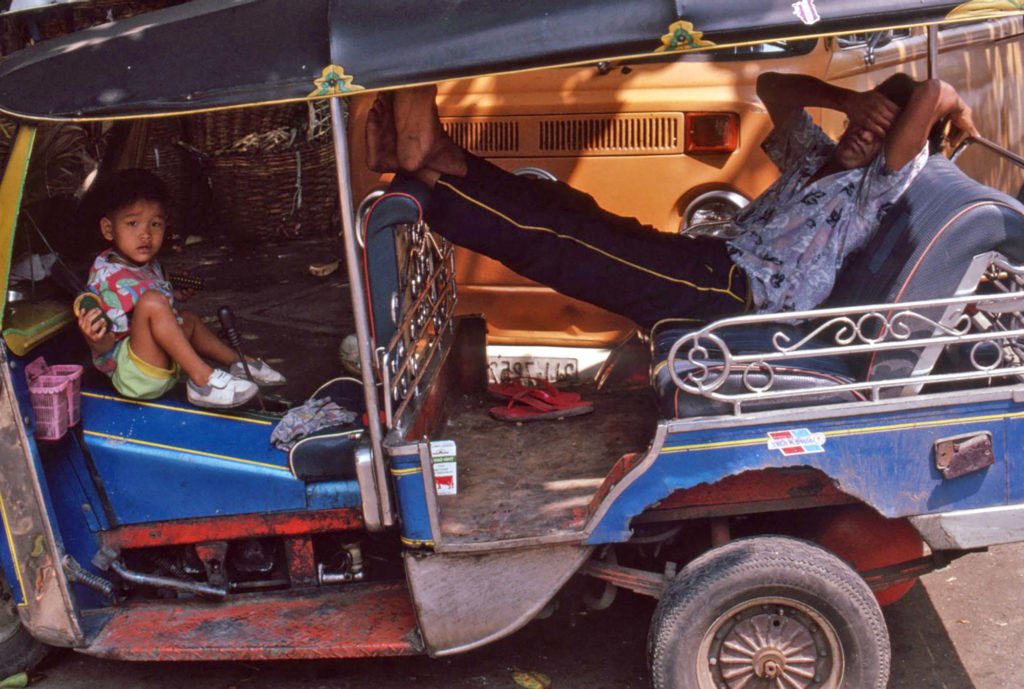
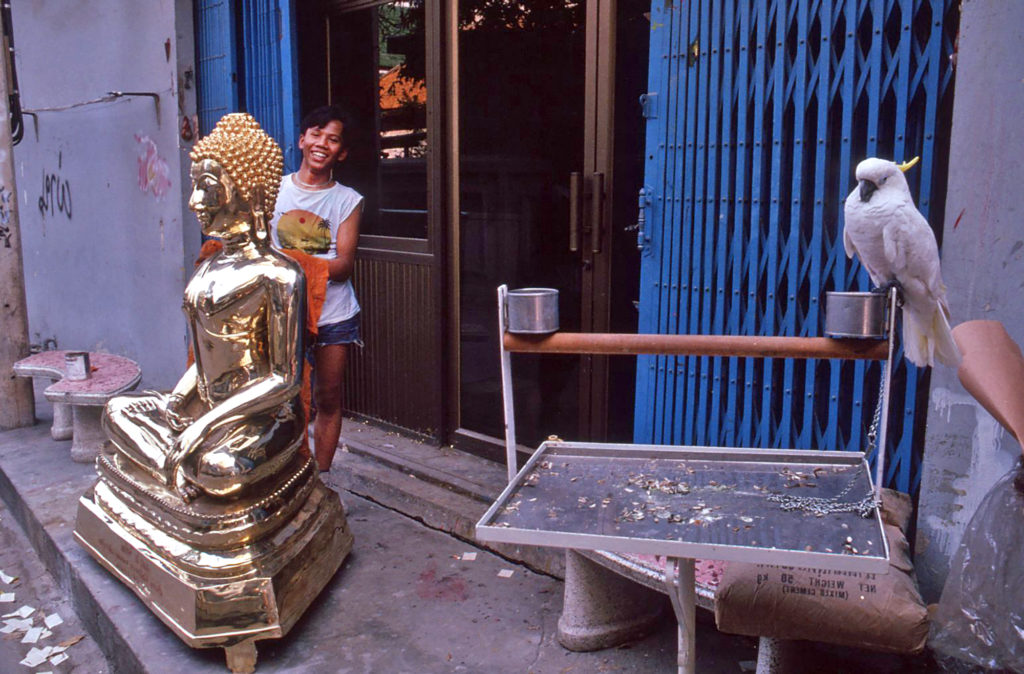
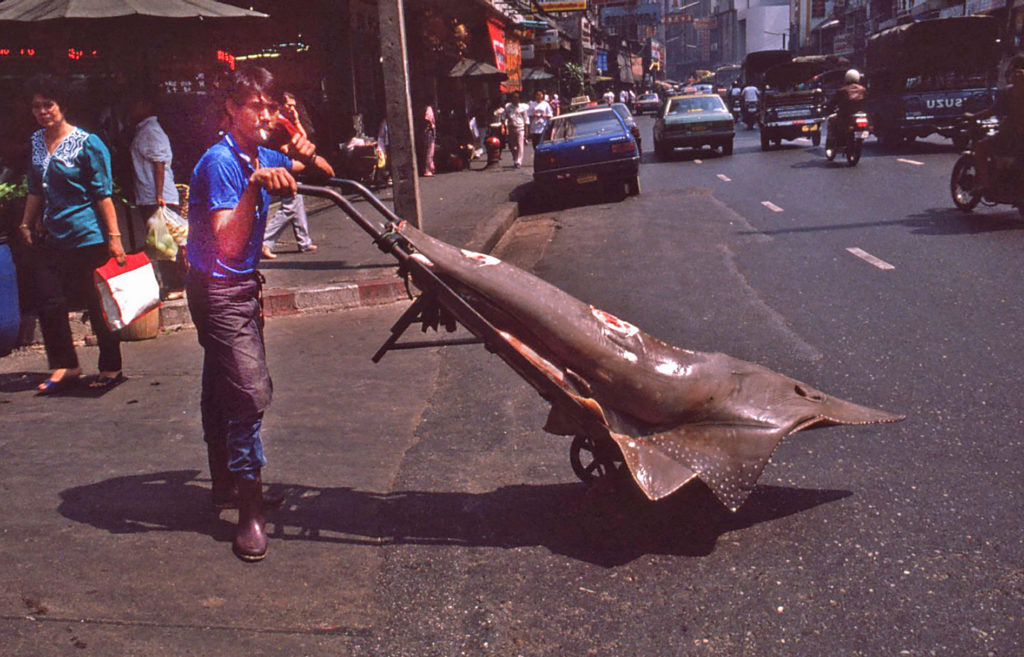
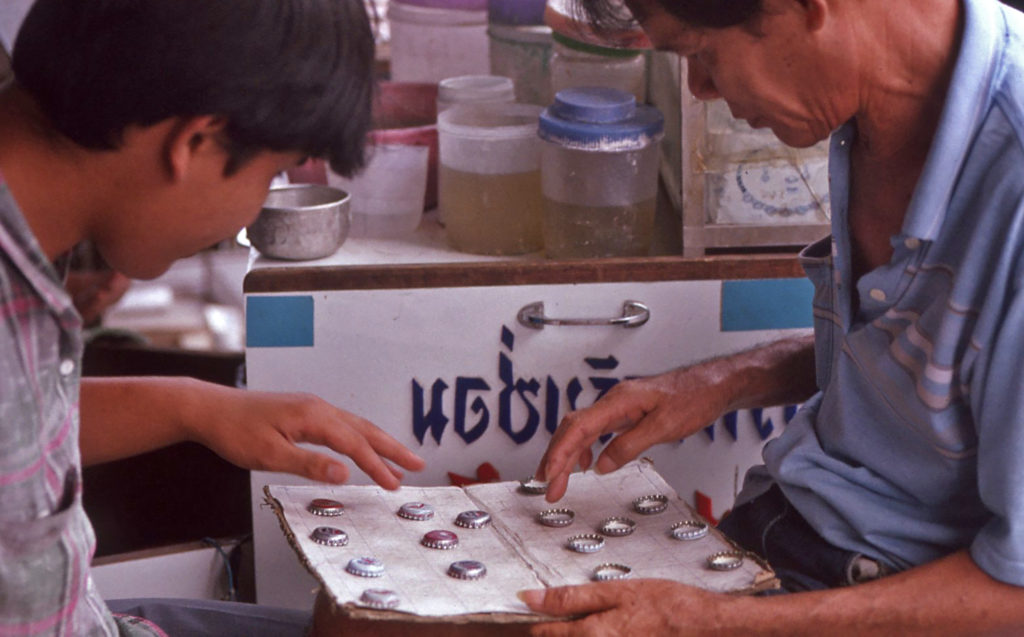
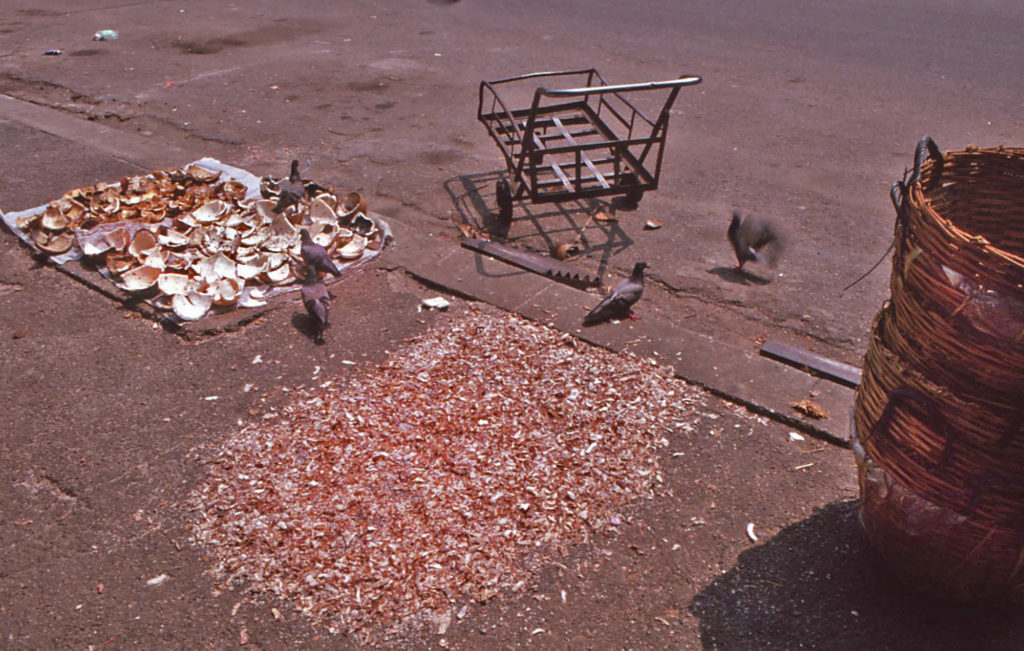



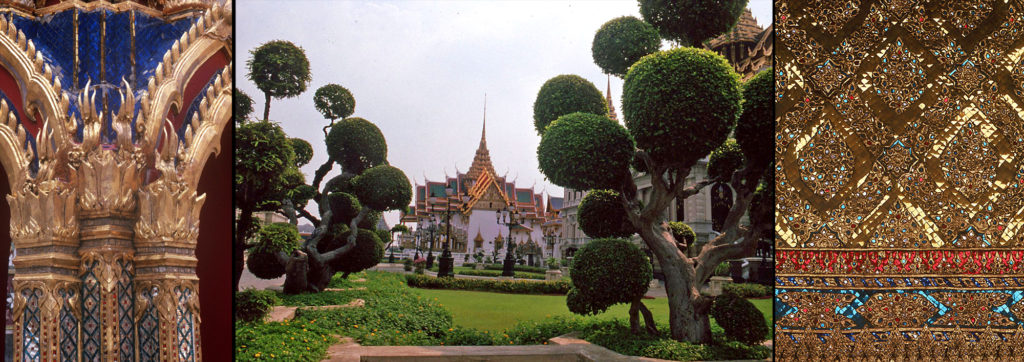
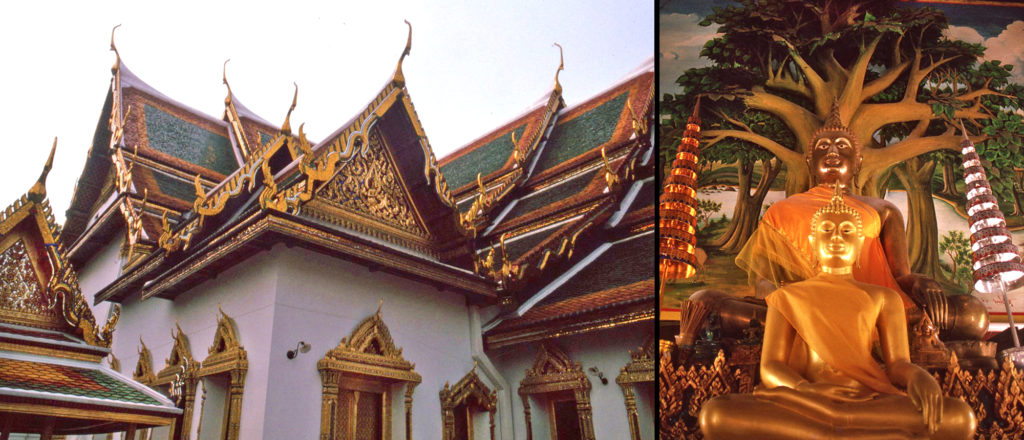

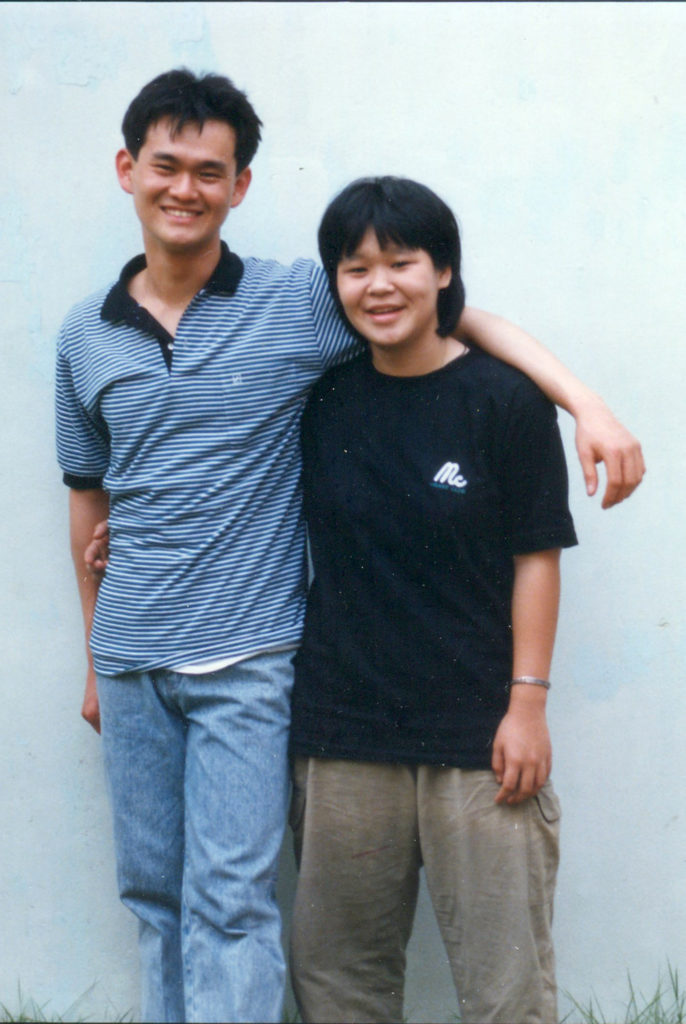

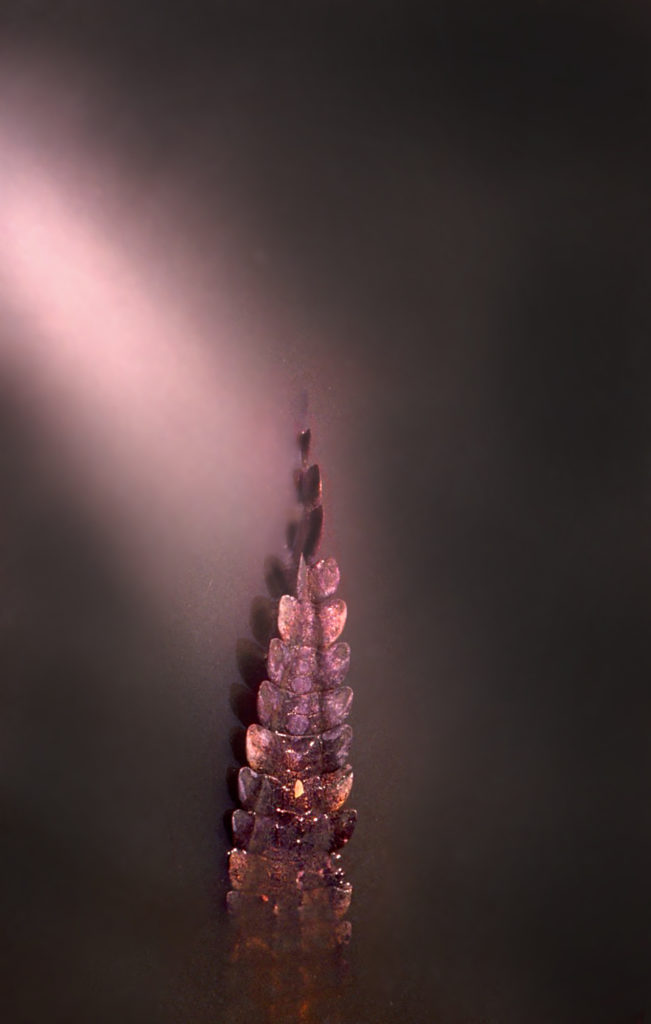
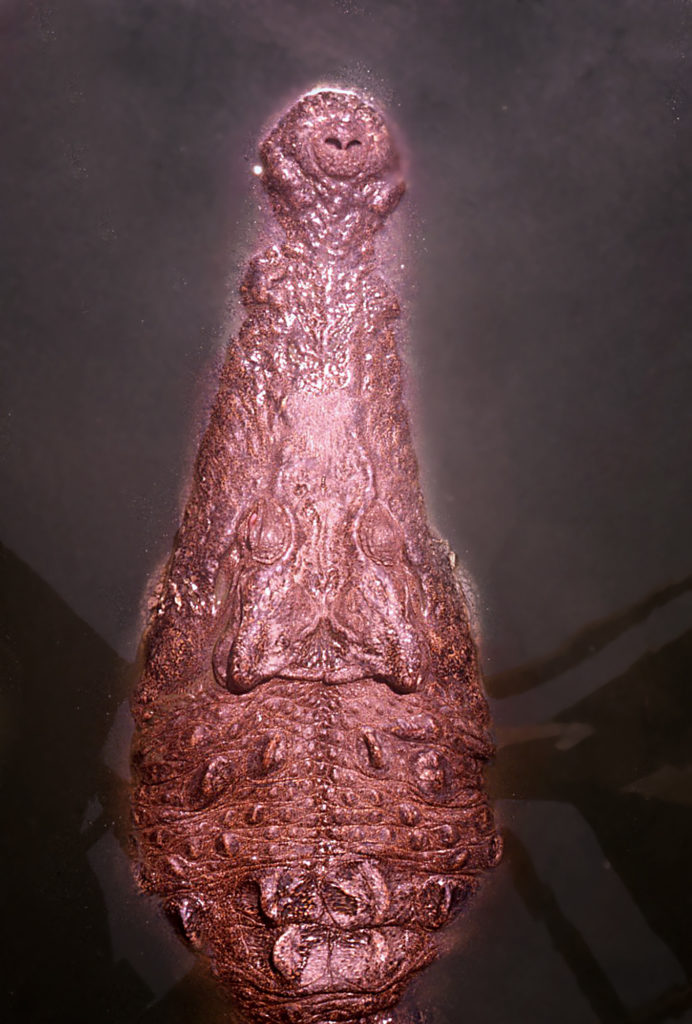
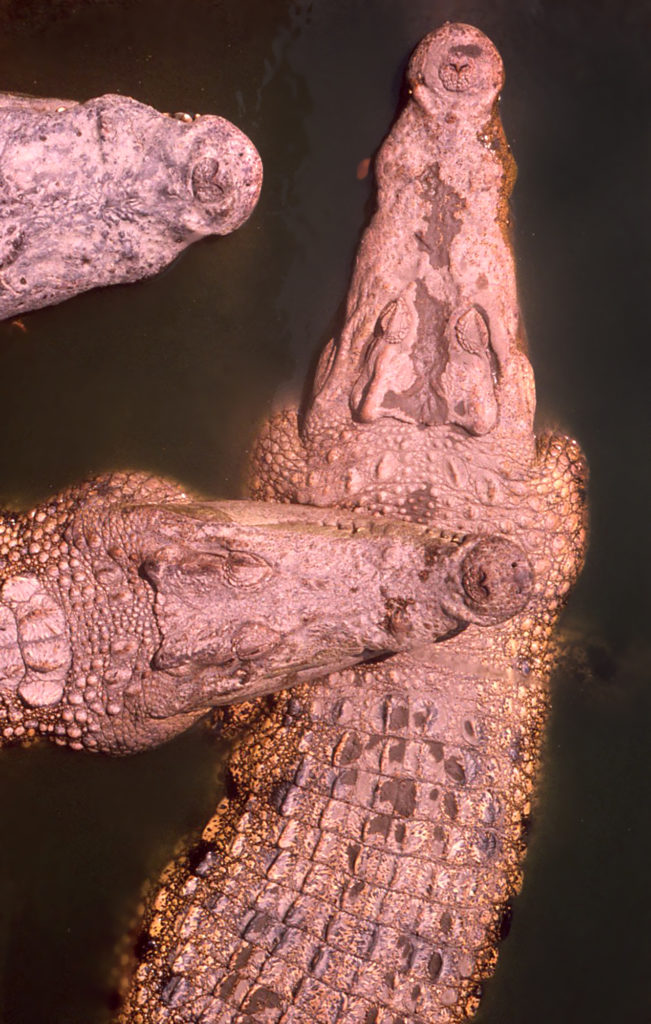


Thailand, known as the land of smiles, is a poor country. Many families cannot afford to feed their children and it is common to abandon baby boys in a basket outside of Buddhist temple doors. These orphaned boys are raised by the temple as Buddhist monks throughout their childhood. They lead very disciplined lives and usually get their own small private room on the temple grounds. They attend classes at the temple, taught by older monks, on subjects ranging from educational basics to the Buddhist way of life which include long hours of meditation and work duties. They get up at 4am and go out with their very own meal bowl to receive food from the community. They are not considered beggars, as their role and job is to represent the spiritual duties of the society. This single meal is the only meal they receive each day. When the monks turn eighteen, they are given the choice to continue their life as a monk in spiritual practice, staying in the security of the temple, or leave the temple and join the materialistic world, which they are usually ill suited to survive in. The temple life for the boys in the crowded city of Bangkok was much like a depressing orphanage compared to temples in the smaller rural villages.
The girls from families that could not support them are a different story. Although there are some female monks, it is less common. It is more common for young girls from the countryside to be sold to pimps in the city. Throughout their often short lives, a portion of their earnings is sent back to help support their families.
Everywhere I looked I saw these boy monks wrapped in orange, became fascinated with them, and began visiting temples to photograph them. After photographing at several large temples in Bangkok, I decided to head north and see what the temples were like in Chiang Mai.
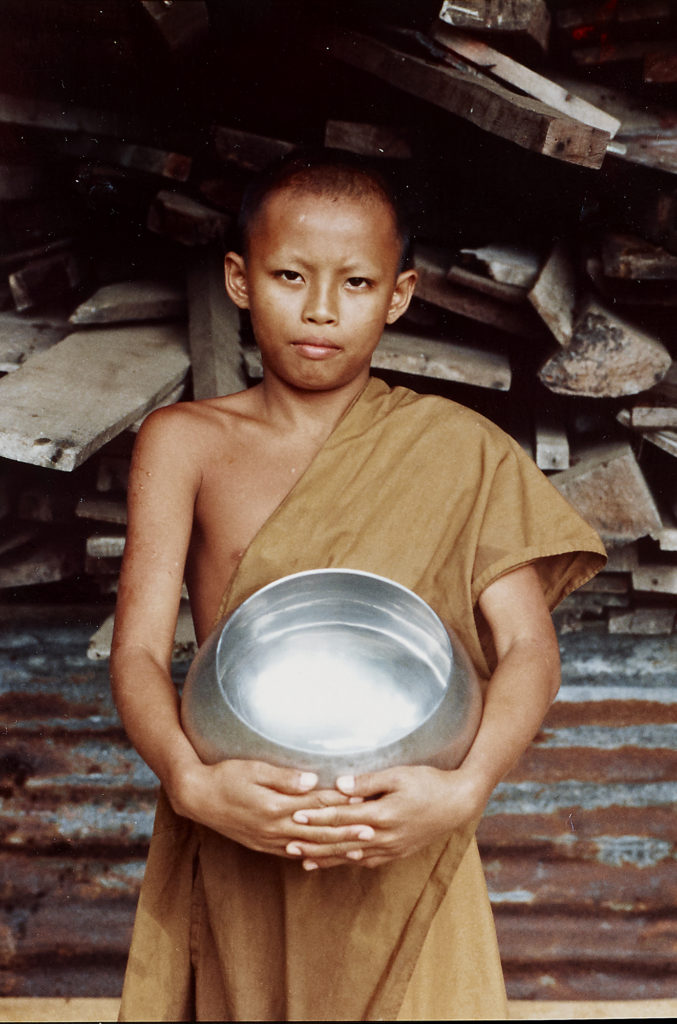
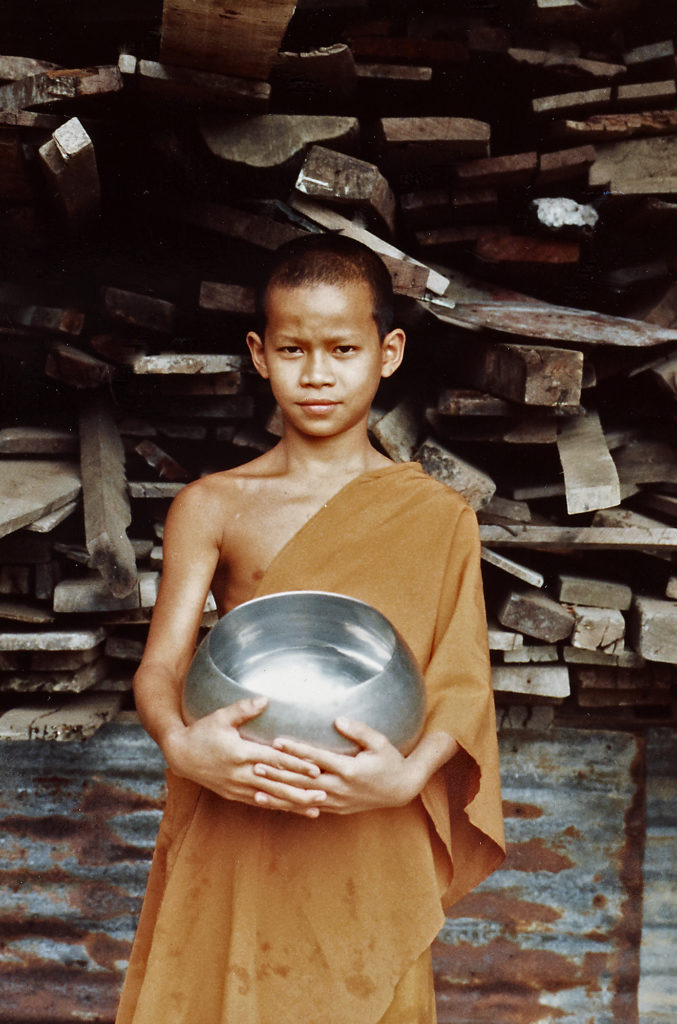
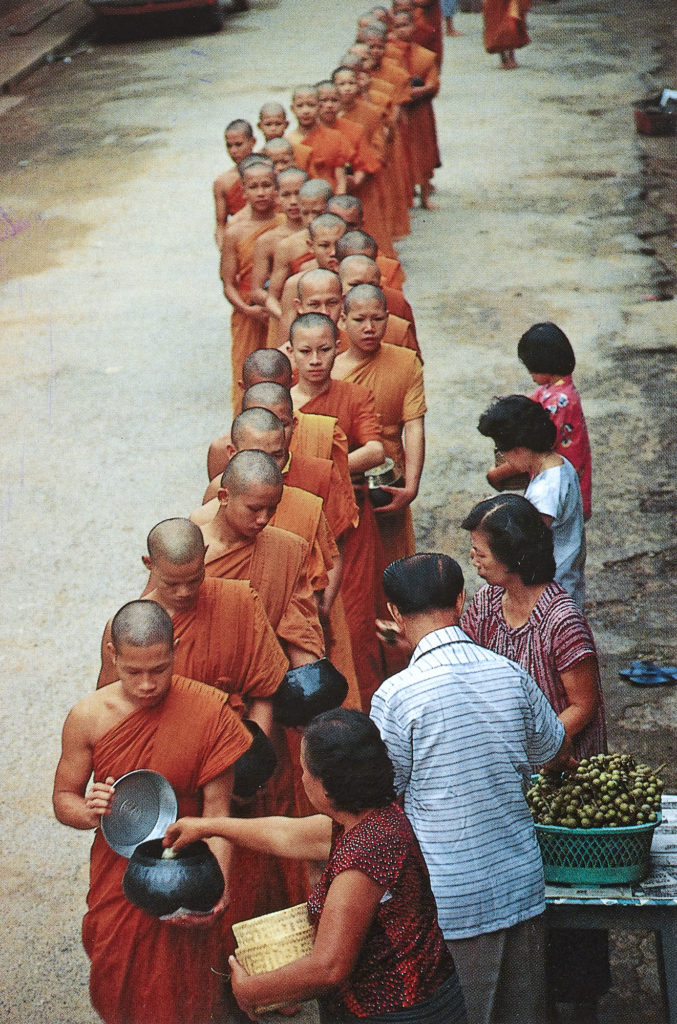
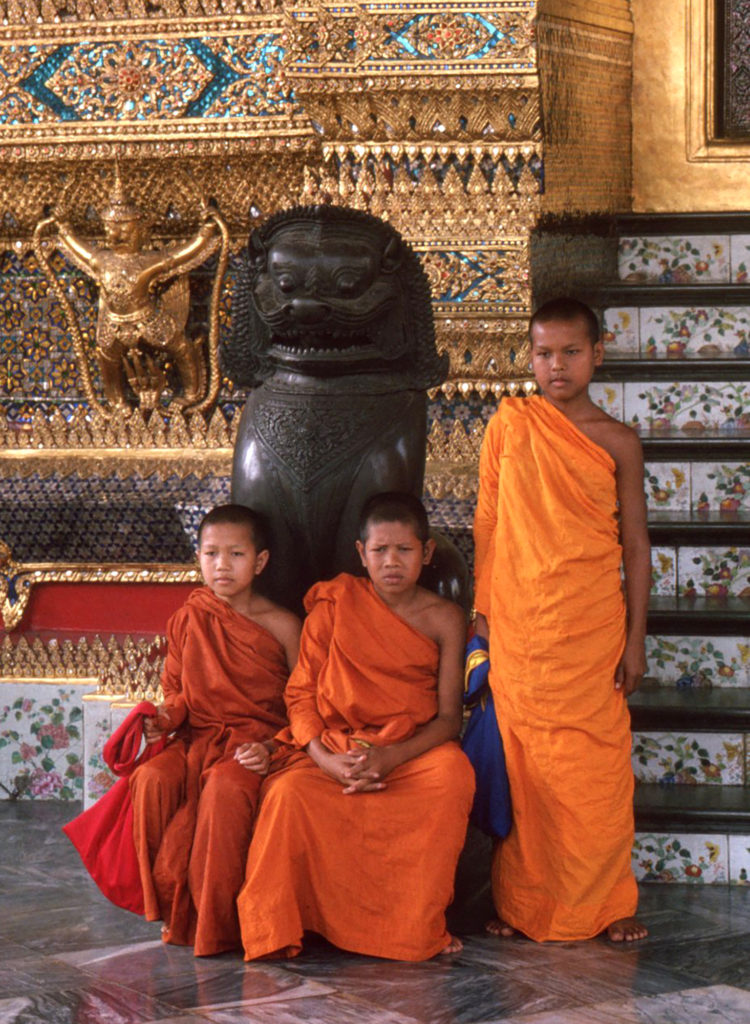
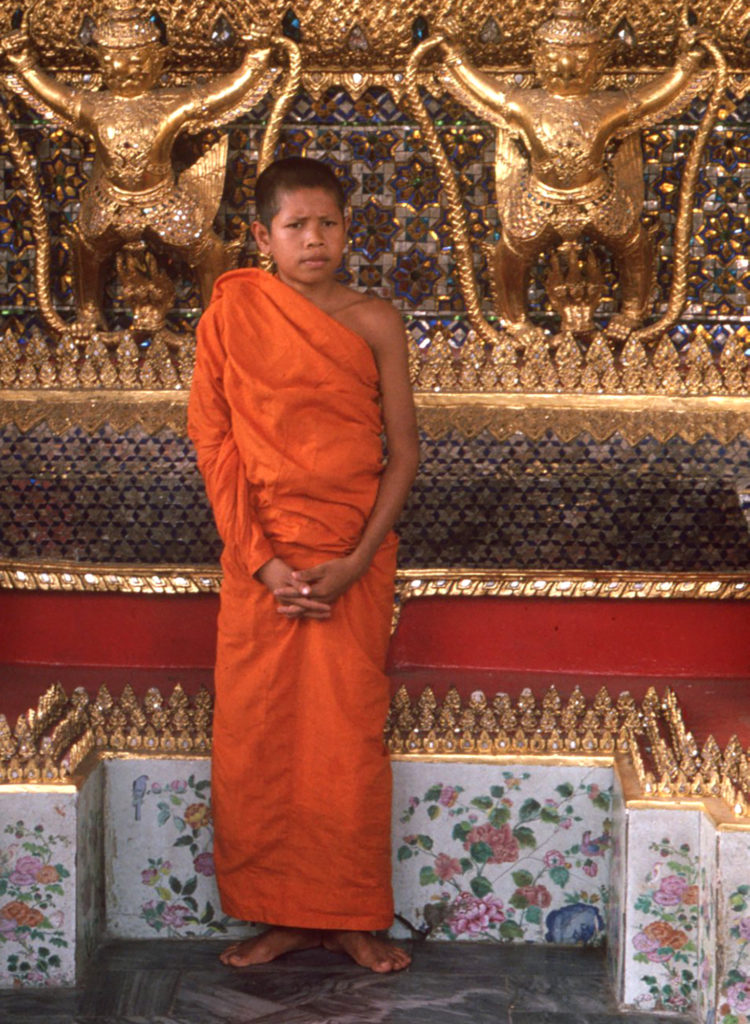
3
Transportation was very colloquial, with limited bus service going north to Chiang Mai once a day. It was an early departure as I left the youth hostel in search of my bus. The air was filled with the pungent smell of spicy Thai food being cooked by the sidewalk vendors, mixed with the choking traffic fumes. Upon finding my bus, it was apparent that I was in for a real grass roots experience. The bus was painted in bright festive colors, much like the three wheeled tuk tuk taxis, and was an expressive visual statement in itself. The front window had huge cracks running across in various directions like lightening bolts, and the front door was missing. There were many fresh, colorful flowers strung across the front of the bus as a blessing, assuring the gods favor to help get us to our destination. Hanging inside the front of the bus was a photo of a white bearded guru of some kind which also bestowed the bus with an abundance of good fortune, which it felt like we would need. The morning was hot and all the windows were open as I entered an almost full bus. As was common amongst Thailanders on hot mornings, many of the passengers had ghost-like faces covered in thick white talcum powder to reduce and absorb perspiration. Being the only foreign person getting on, I must have looked equally curious. Everyone stared and smiled at me as I threw my backpack overhead. I smiled a friendly smile, nodded, and gestured in courtesy to sit next to an older woman who was traveling with a chicken in a small cage. I assumed she had family in Chiang Mai who were waiting for a chicken dinner that night, but in the meantime, it was clucking calmly as if it were her pet. Her approving toothless smile radiated in return for me to have a seat, along with a friendly, inviting cluck from the evening dinner. Then off with a jerky start we barreled and dodged through the crowded and frantic streets of Bangkok, heading out onto the only road north to Chiang Mai.
Aside from the driver, there were three other bus employees along to help manage the nine-hour trip. One was the “cow-prodder” boy and the other two were our female stewardesses. The cow-prodder boy hung out of the open door throughout the drive in order to jump off the slow moving bus, prod cows off the bumpy road for us to get through, then jump back on as the bus picked up speed.
After a while, our video entertainment began. There were three VHS video screens spaced overhead through the bus for which a single movie played in a continuous loop several times during our drive. The movie was an American movie – lucky for me as I could not read the Thai subtitles. The movie was perhaps the most surreal of anything thus far on this passage north. I kid you not, the movie was the 1968 black and white classic horror film Night of the Living Dead, complete from beginning to end with low-budget attempts at depicting flesh-eating ghouls with big, rotting eyes and sharp teeth for feasting on the living. Shortly after the movie started, our two bus stewardesses, dressed in identical blouses, button caps, and mini skirts, wobbled up the aisle in a precarious balancing act, holding a tray of refreshments in one hand and using the other to hold on for dear life. They were young, thin, beautiful, and carried huge, infectious smiles as they offered the passengers a choice of two beverages in paper cups. One beverage was grape Kool Aid and the other beverage was orange Kool Aid. I chose orange (just to indulge myself completely in the experience) and sipped as I alternated between watching the zombies eating their snacks and watching the countryside pass by behind the caged chicken.
Once in Chiang Mai, I found a guest house to check into. It had a bulletin board and an old-fashioned telephone in the lobby lounging area. Pinned onto the bulletin board was a short advertisement for excursions into the remote mountain hill tribe villages. I called and talked to the guide to find out more about this intriguing possibility. As it happened, there were a couple other people in the guest house who were also interested, and with our small group, the guide scheduled a week and a half excursion for us. The next morning I was on my way to the adventure of a lifetime.
Our guide picked us up early from the guest house. He was a young, handsome Thai man, named Jan, who was raised in the area and spoke Thai, English, four hill tribe languages, and knew his way through the paths and waterways of the mountains. He brought an assistant to help with trek-related labor. Our group consisted of eight people in all. There was a young adventurous couple from France, three young men from Germany, myself, our guide, and his assistant. I immediately bonded with our guide and the couple from France. I found the guys from Germany to be quite obnoxious with their macho, narcissistic attitudes. For better or worse, we all excitedly commenced our journey with a three-hour ride in the back of a pickup truck. With handkerchief-covered faces, it was impossible to talk as we struggled to breathe the dust stirred up on the dry, dirt road.
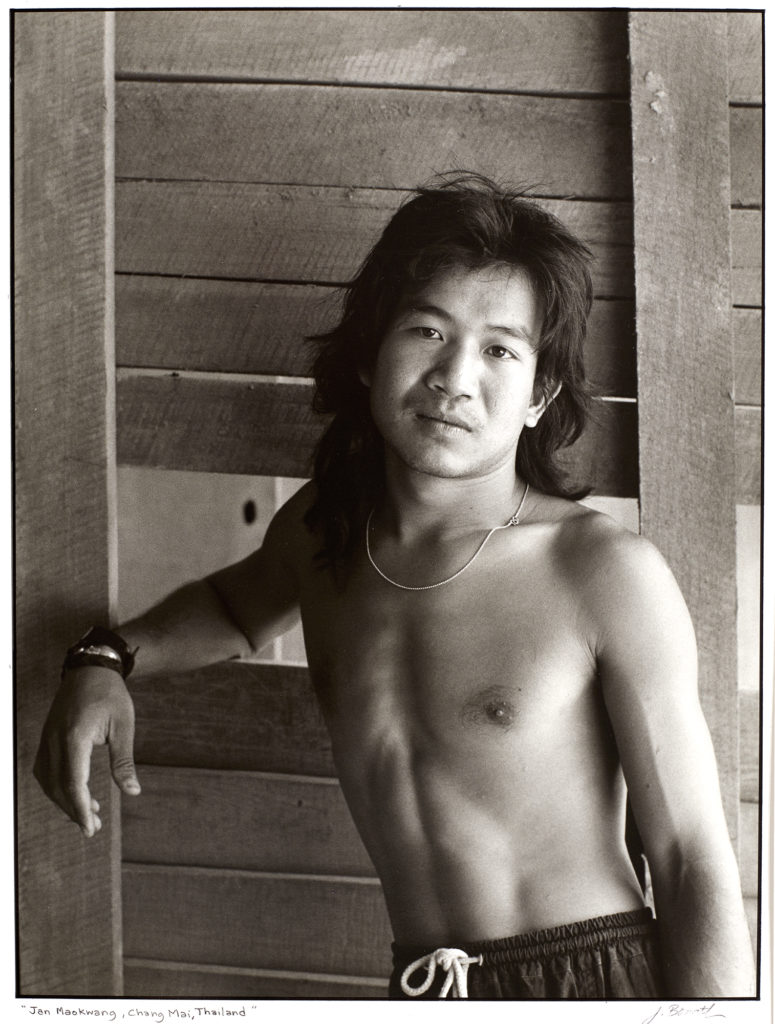
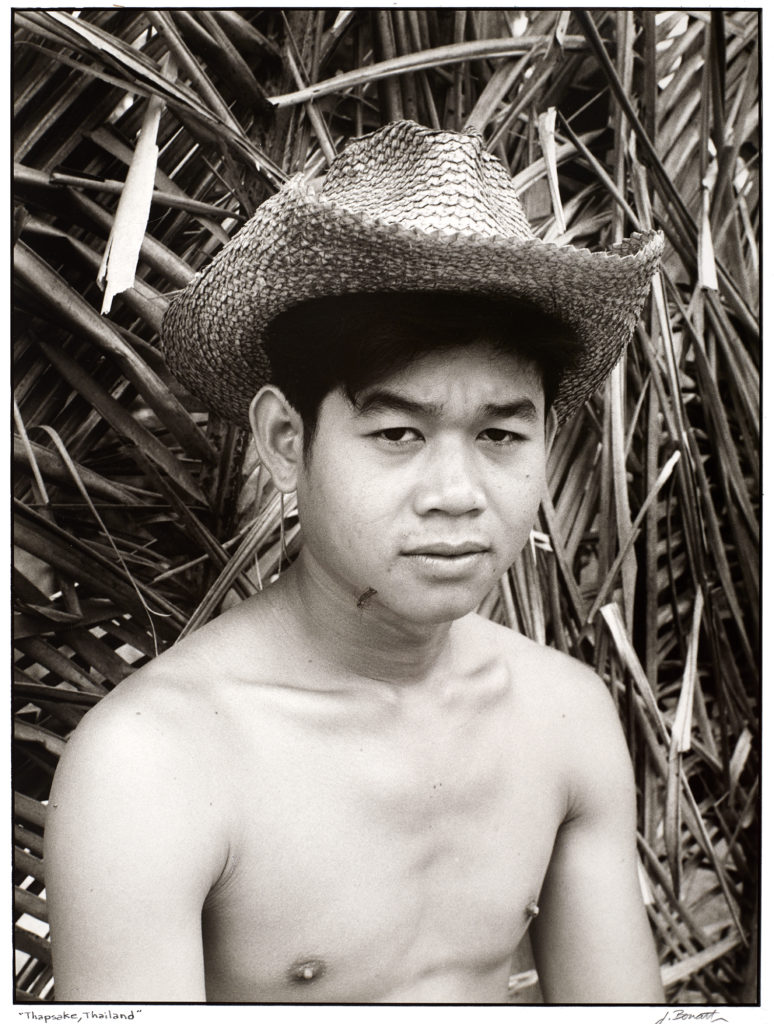
At the end of our drive we were dropped off in the middle of nowhere at a trailhead, marked by an old wooden box mounted on a pole. Inside the box was a ledger book. Inside the book we recorded our names, nationality, and date before proceeding further. It was explained to us that we were entering the “Golden Triangle” region of Thailand and our data in the book was a simple record that we had ventured beyond, in case we did not return. The Golden Triangle (bordered by Thailand, Laos, and Burma) was the world’s leading source of heroin and opium production and was its own little territory. Ahead were many mountains in which lived various tribes of people that had mostly migrated from the cold mountainous regions of China centuries before. Each mountain village was relatively isolated, spoke its own language, and lived much like they did centuries ago. Child mortality was high in that perhaps one out of every five children lived past four years and reaching thirty was considered old age. Around once a month, someone from a village would take a mule through the mountain trails to the area trading post and get various goods for the village such as cigarettes, Coca Cola, and sometimes used clothing donated from American church groups. These were the types of villages we were headed to visit.
After being dropped off at the trailhead, we trekked on foot through hot wastelands and jungles for the next six hours. We spent our first night at an elephant base camp in the jungle. The Thai history of the special relationship between elephants and humans was well and alive as we experienced first-hand. The following morning, we began the next leg of our journey riding on the backs of our elephants. The elephants had baskets strapped to them that could carry several people. It was my preference, instead of the basket, to ride directly on my elephant’s head, with my legs straddled behind the backs of its ears. It was an elephant’s eye view from high atop my perch. As in a dream, I rode atop my new friend’s head for the entire day. When the elephant walked, my body swayed left and right with its shifting weight. My hands balanced on its skull and its ears constantly flapped against my legs, fanning the both of us throughout the heat of the day. When the elephant got hot, it would put its trunk in its mouth, obtain large amounts of saliva and spray it on itself… and me. Its water smelled exactly like an elephant and by the time we were at our day’s end, the elephant and I were not only bonded but smelled as one.

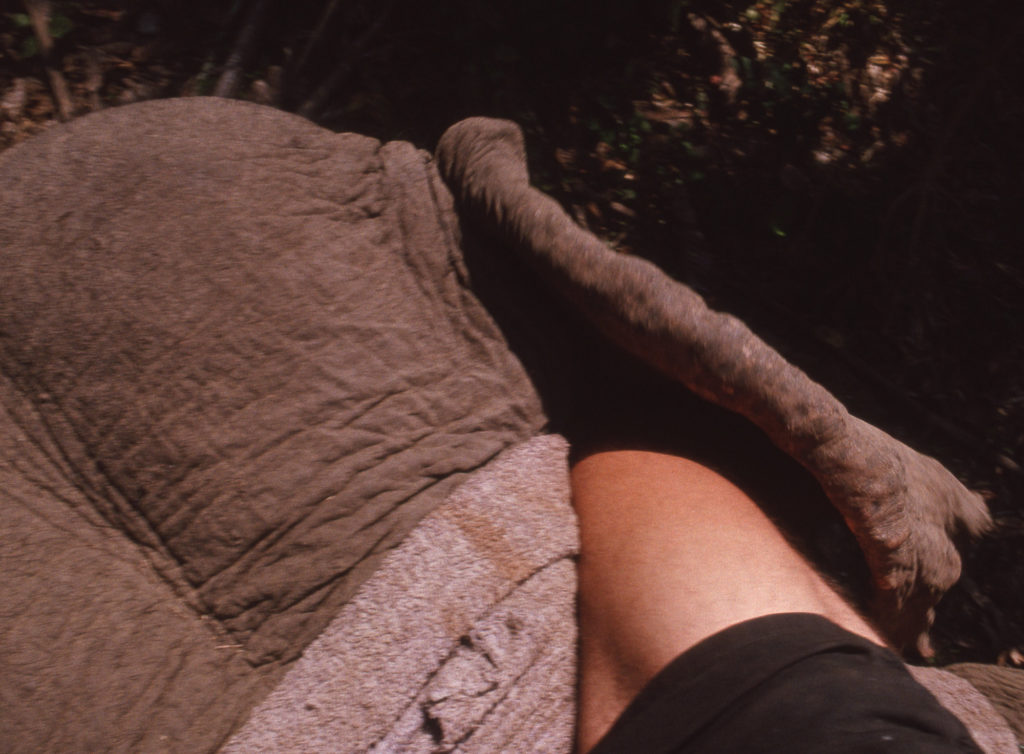
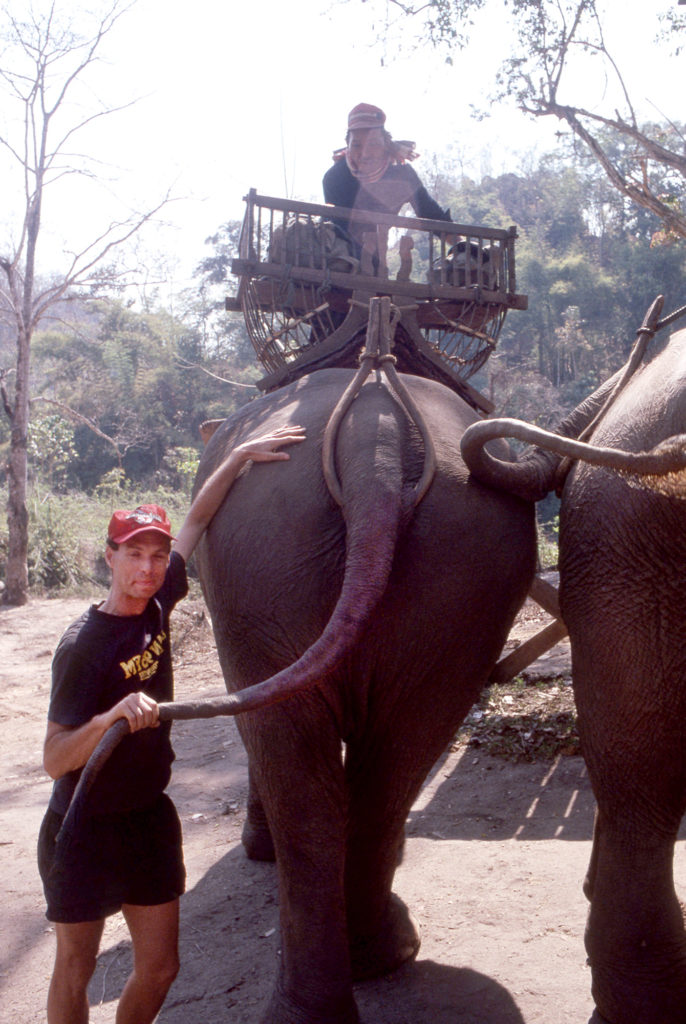
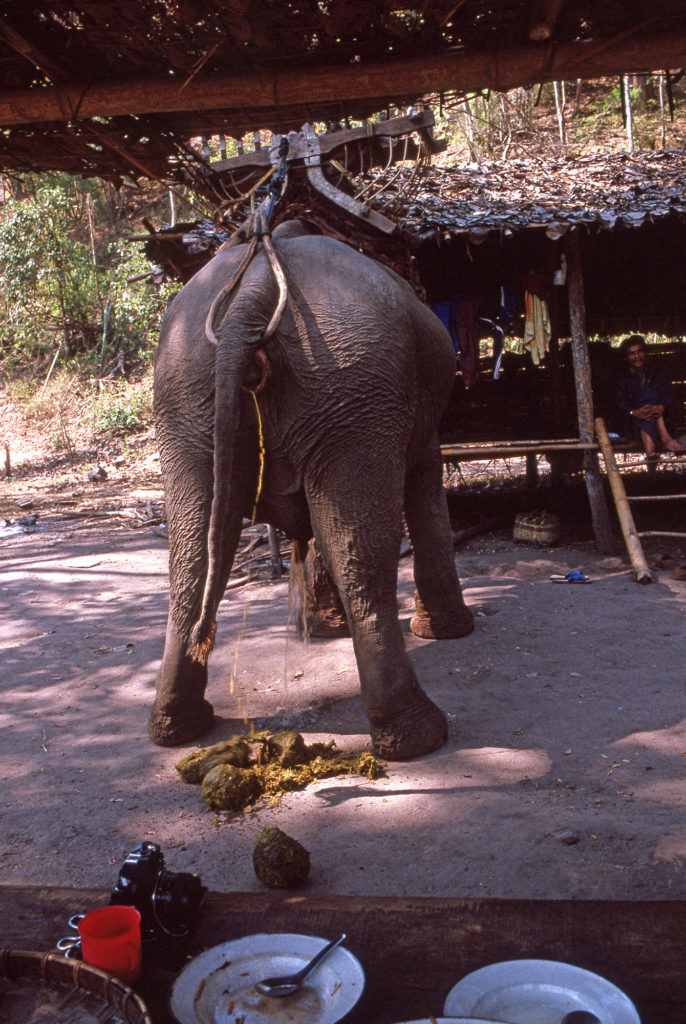
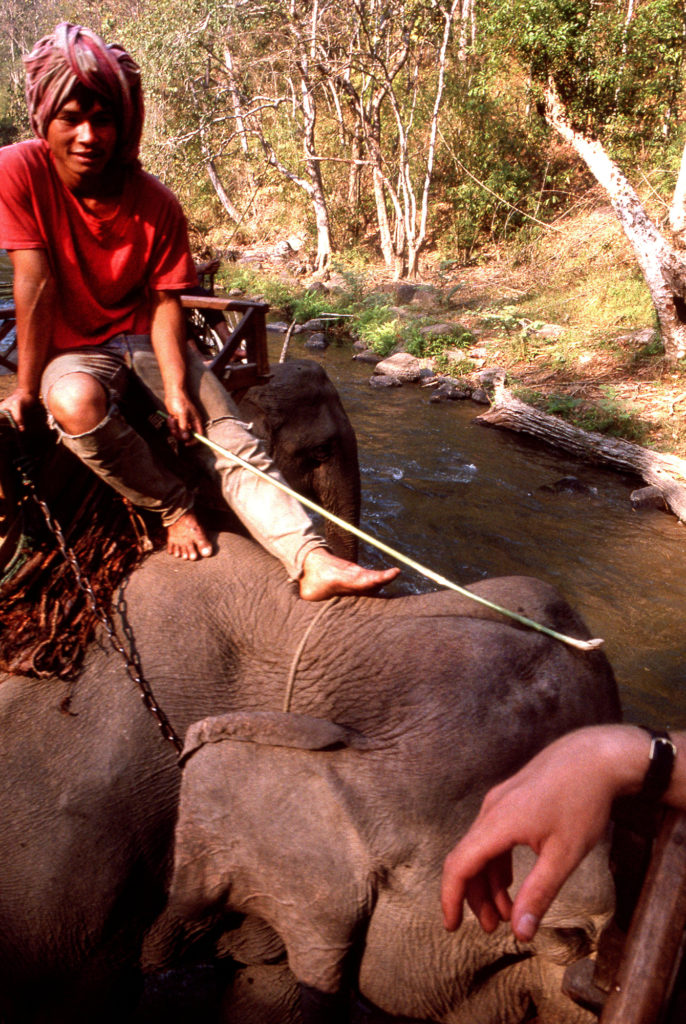


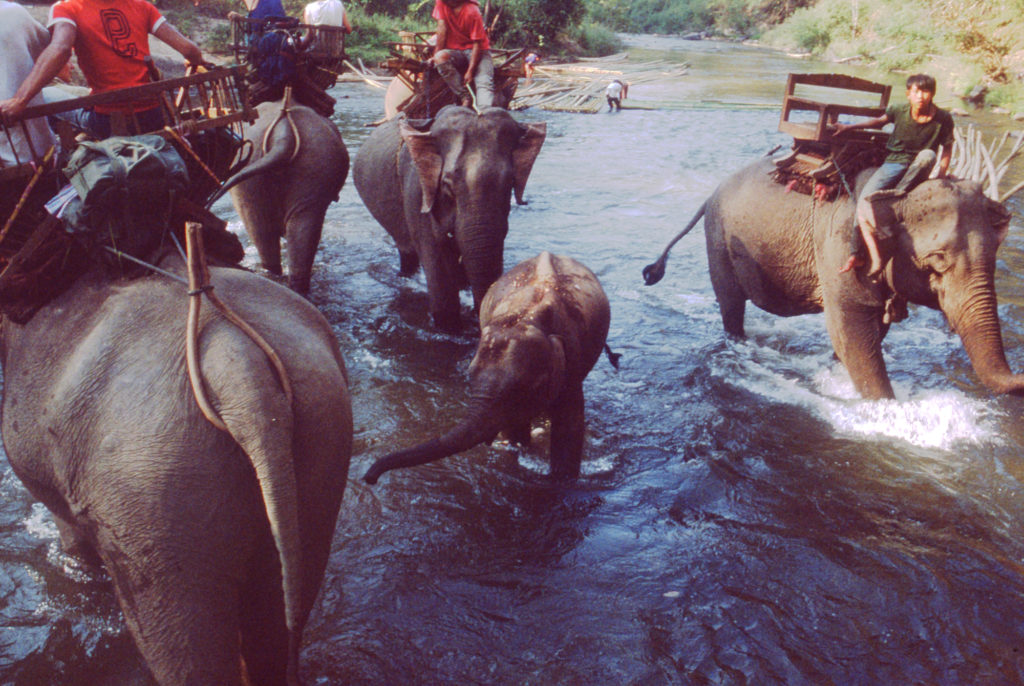
We ended our day at a large river where many elephants were kept. By the end of a hot day of travel, we were all ready to bathe in the river alongside the elated elephants who got bathed by their keepers.
The next morning we headed up the river for several days, our destination being a river trading post and our first hill tribe village. Before we got up, our guide went into the jungle with his assistant and a couple machetes. They returned hauling long bamboo poles and jungle vine which they confidently began to cut and tie. They fabricated three bamboo rafts with a tripod of poles in the center that we secured our packs and supplies to.
We divided into three groups. One person from each raft was in charge of steering. The steering person was at the front of the raft and had a very long bamboo pole to push off from the river bottom and guide the craft as it progressed downstream with the current. Our guide, Jan, knew the river well and took the first raft. The second raft was steered by his assistant. I was the only other person with “river experience” (a boy scout merit badge in canoeing when I was in elementary school…), so I was assigned to steer the last raft, and off we went down the river. The first day was heavenly as we glided over a glass smooth surface through lush jungles. Monkeys watched from the trees and colorful jungle birds sang as we glided soundlessly through it all. Steering was a breeze and very relaxing. That night, we camped at a riverside clearing that our guide was familiar with.
Before heading out the next morning, we got a briefing informing us that later downstream we had some rapids to get through before arriving at the river trading post. The day proceeded much as the previous, silently gliding down the smooth mirror-like water that reflected jungles and blue skies. Several peaceful hours passed before we started to hear the sound of crashing rapids in the distance gradually getting louder and louder. I was instructed to follow our guide’s lead through the rapids. The current accelerated and became tricky to navigate as we began to head into the white waters ahead. The rushing waters headed straight for a giant rock island in the middle of the river. Before this rock mass, the river’s current became menacingly swift with thrashing waters heading straight for the precipitous rock then suddenly splitting dramatically to the left and to the right. The only way to get through was to let the waters take you straight for the mammoth rock, then at just the right moment, push the raft with great force to the left down into the center of the rapids. With adrenaline pumping full force through my veins, I studied exactly when our guide and his assistant made their thrust. Perfect timing was critical; without it, one was destined to meet the great rock head-on and be smashed to shreds.
I waited for just the exact moment and without hesitation thrust my long bamboo pole deep into the river bottom. Unlike the bottom of the smooth river water I was used to, the rapids were a mass of boulders under the swirling water’s surface. When I thrust my pole to the river floor, instead of pushing off, the pole jammed between two boulders at the river’s bottom and got stuck. Knowing everything depended on being able to recover the pole, I held onto the precious pole with all my might. The long bamboo pole would not budge and began to flex as the raft proceeded. After bending to its max, the pole catapulted me ten feet into the air – exactly like a pole vaulter. In the absence of me and the pole, our raft crashed straight into the rock with massive force, shattering it apart with the Germans onboard. I came down in the middle of the rapids and was immediately forced underwater by the crashing waves, which thrashed me against rock after rock on the river’s bottom. I swallowed a stomach full of this jungle water, containing everything from monkey and elephant dung to yet undiscovered microbes of unknown origin.
Despite the tropical heat, the river water was like ice. After the rapids, I managed to make it to the edge of the river and pull myself onto land. At that point I was badly bruised, vomiting river water, and in complete shock. Hypothermia had set in as I trembled with chattering teeth in the hot sun. The crew was able to back track and wrapped me in a blanket, shaking and in shock. Somehow, the Germans survived the crash. After constructing a new raft out of what could be salvaged and some new cuttings, I was laid aboard and we proceeded to the river trading post. Fortunately my waterproof camera bag was recovered, but a camera I had out and some film were lost to the river. I was lucky enough to have some antibiotics in my emergency supplies and began taking them to head off the plethora of water-borne pathogens that I ingested.
After resting and a bite to eat at the river trading post, we hiked up the mountain trail to our first hill tribe village. As we entered the village, there was an entry post on each side of the dirt road. High atop the left post was a hand-carved statue of a naked man with a large erection. On top of the post to the right was a hand-carved airplane. I surmised that the people might worship the airplane as a bird-like god. It was hard to believe such a thought in this day and age, but we were passing into a way of life that had changed little over centuries of time. Upon entering through the primitive gateway, the first human I saw was an infant, perhaps one or two years old, crawling on the dirt in front of some huts. Someone had thrown a smoldering cigarette butt on the ground, the child crawled over to it, picked it up, put it to his lips, and began to feebly suck on it. The baby’s ability to mimic the behavior of those around was astounding and depressing. All the males were smokers and no age was too young to begin.

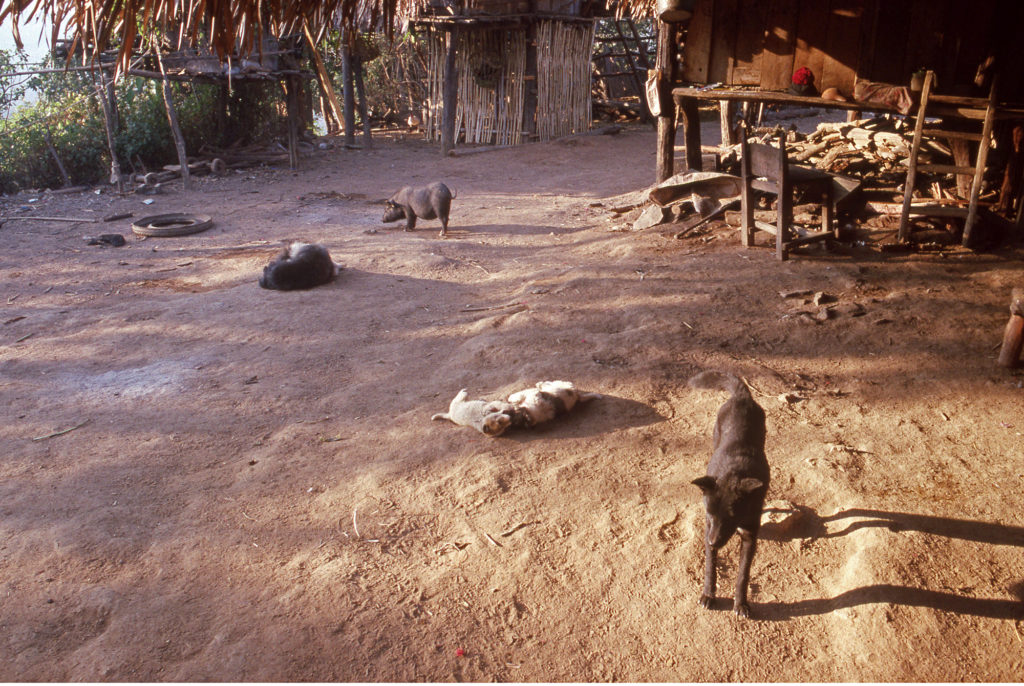
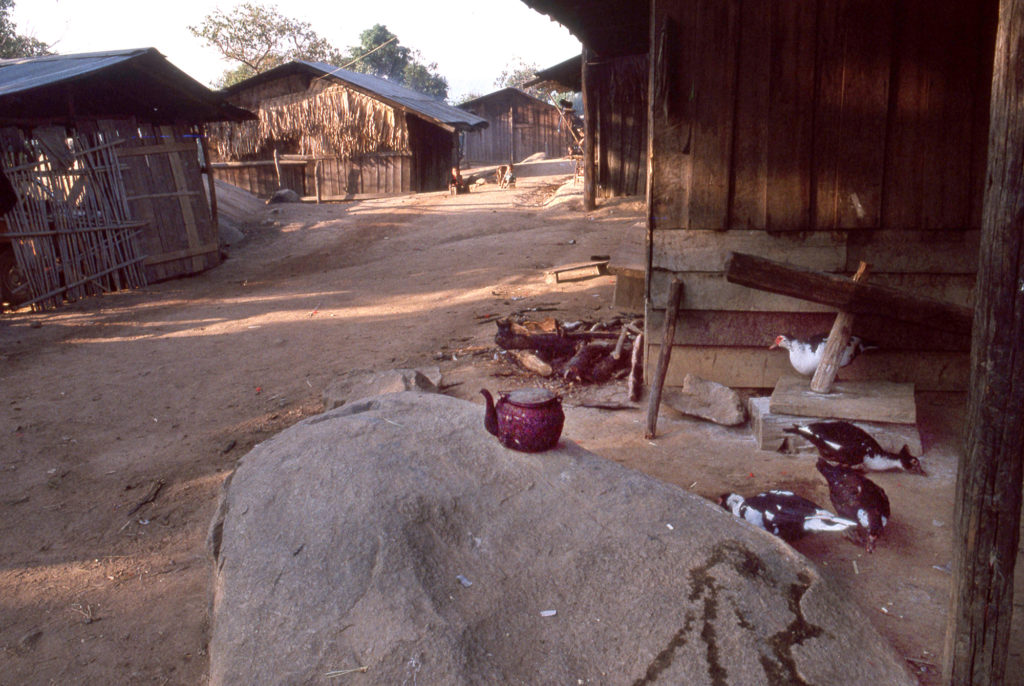
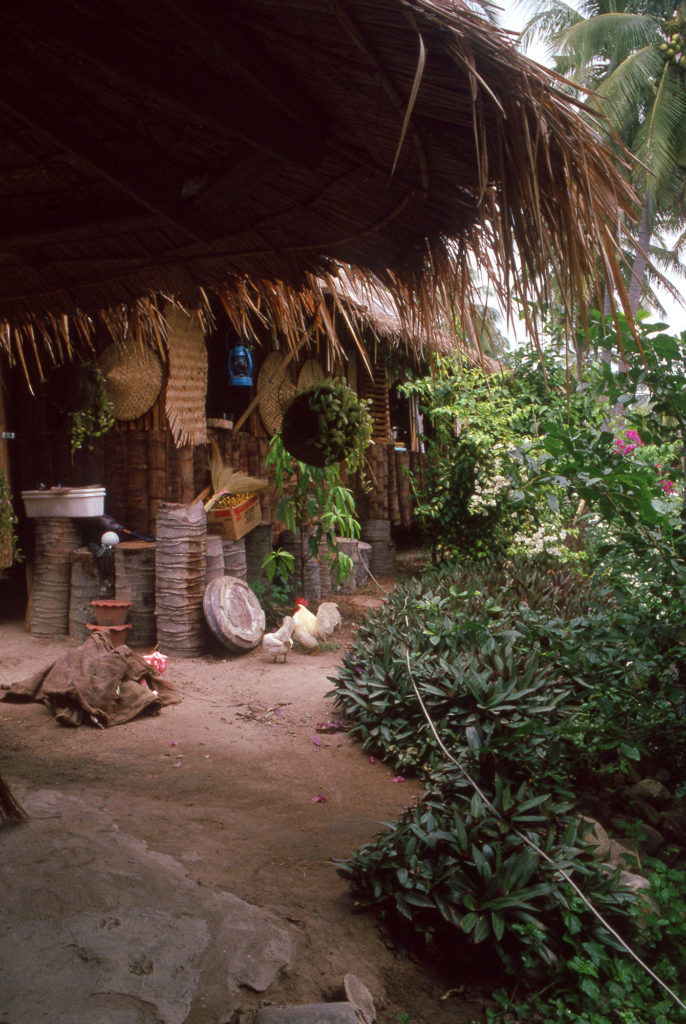
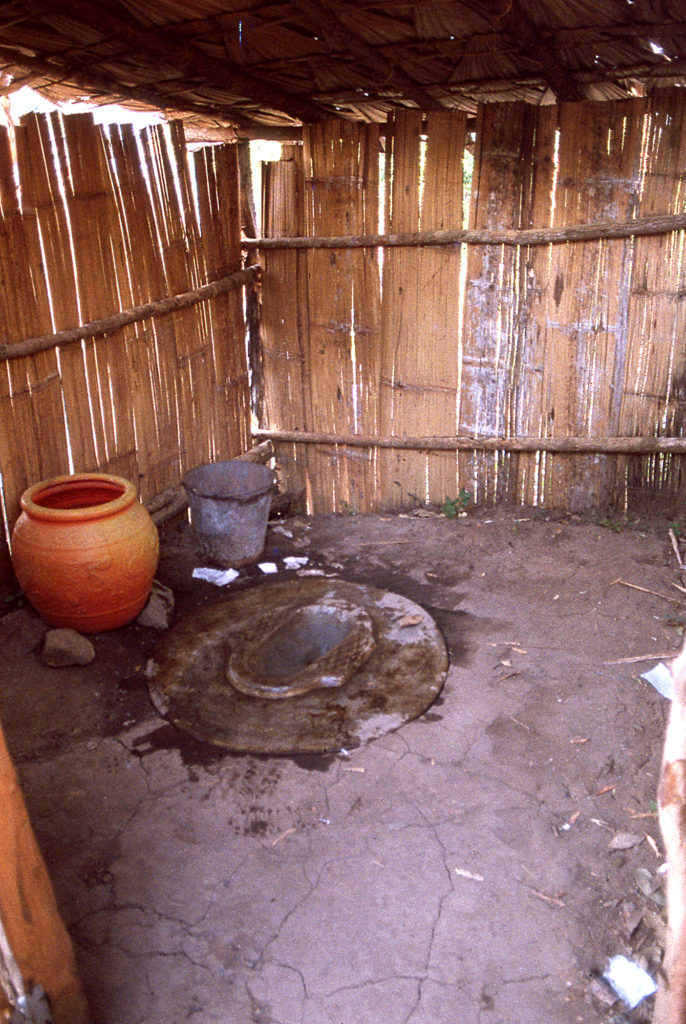
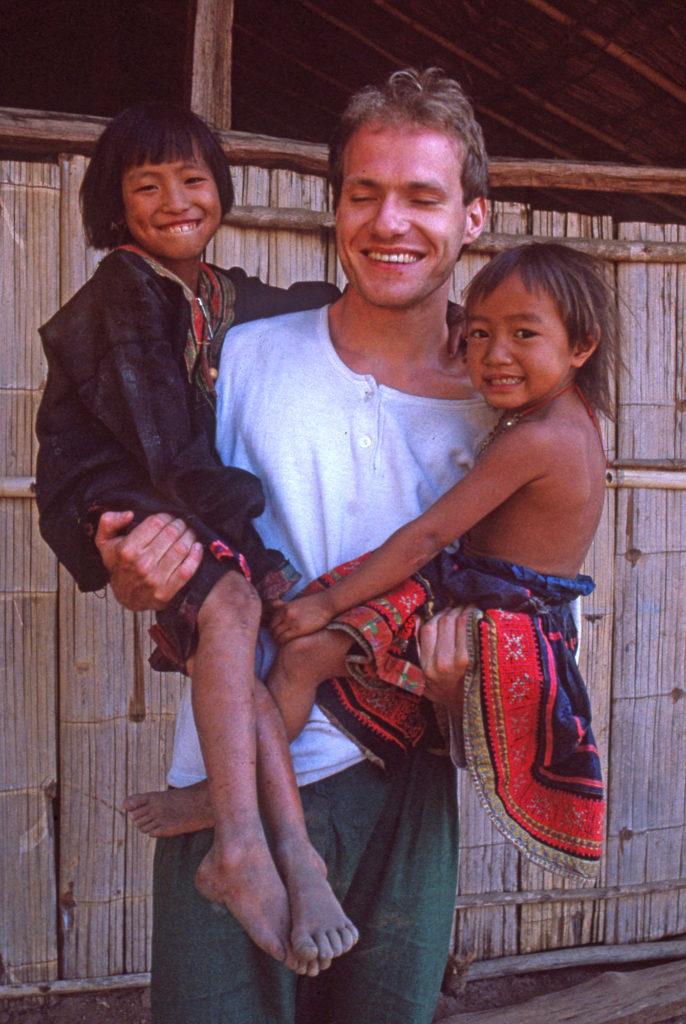
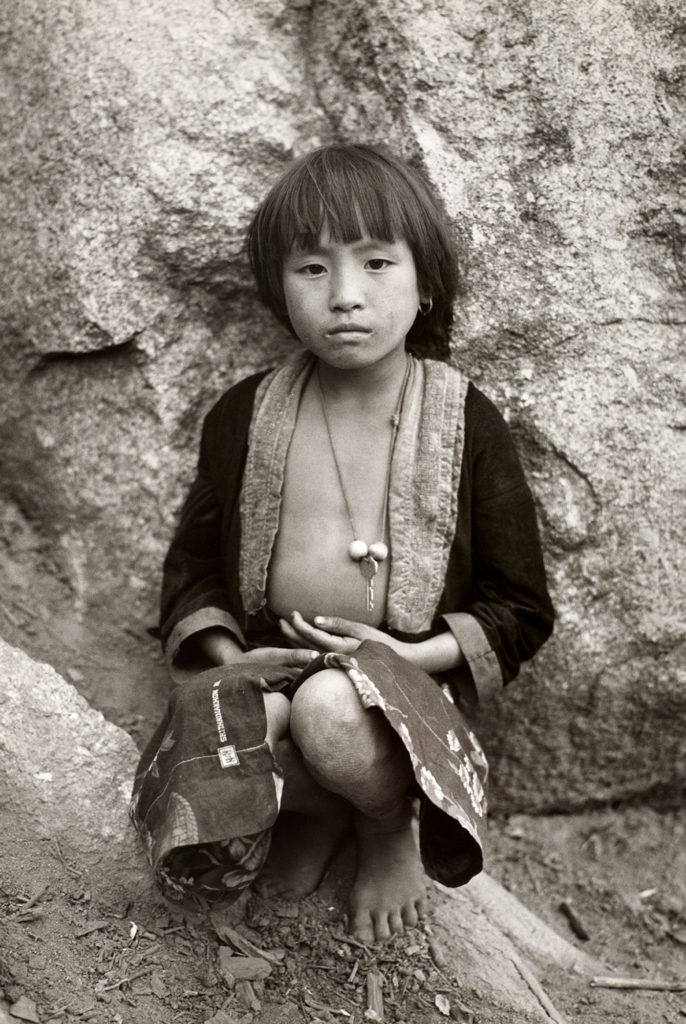
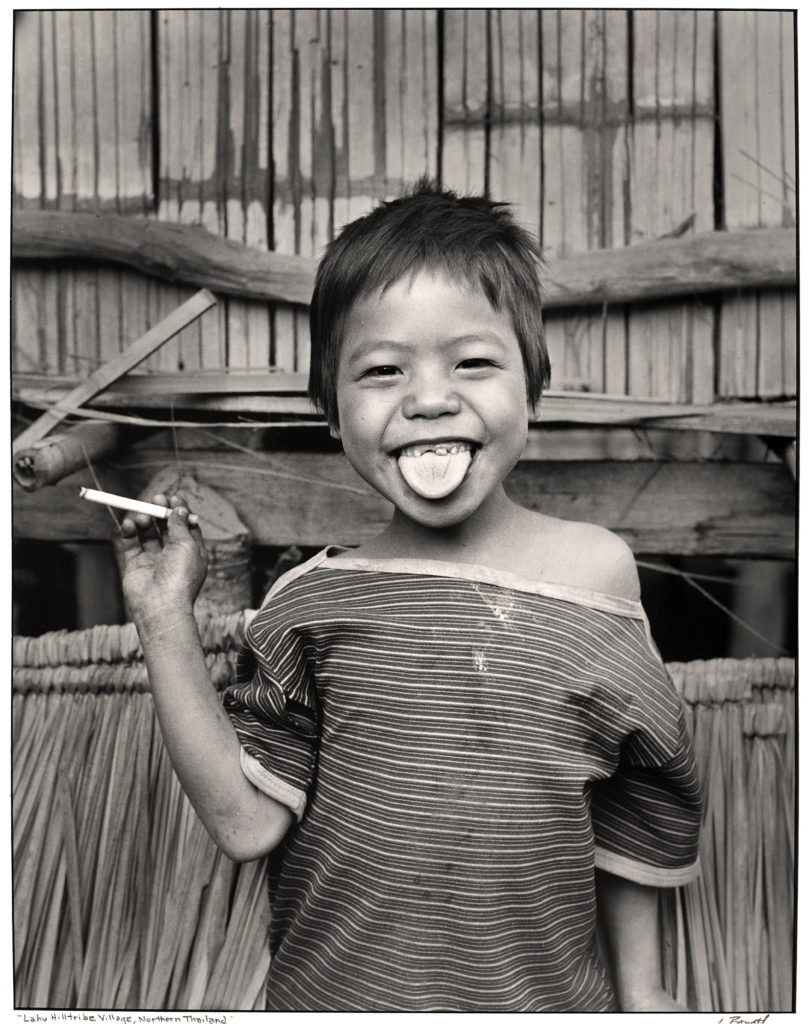
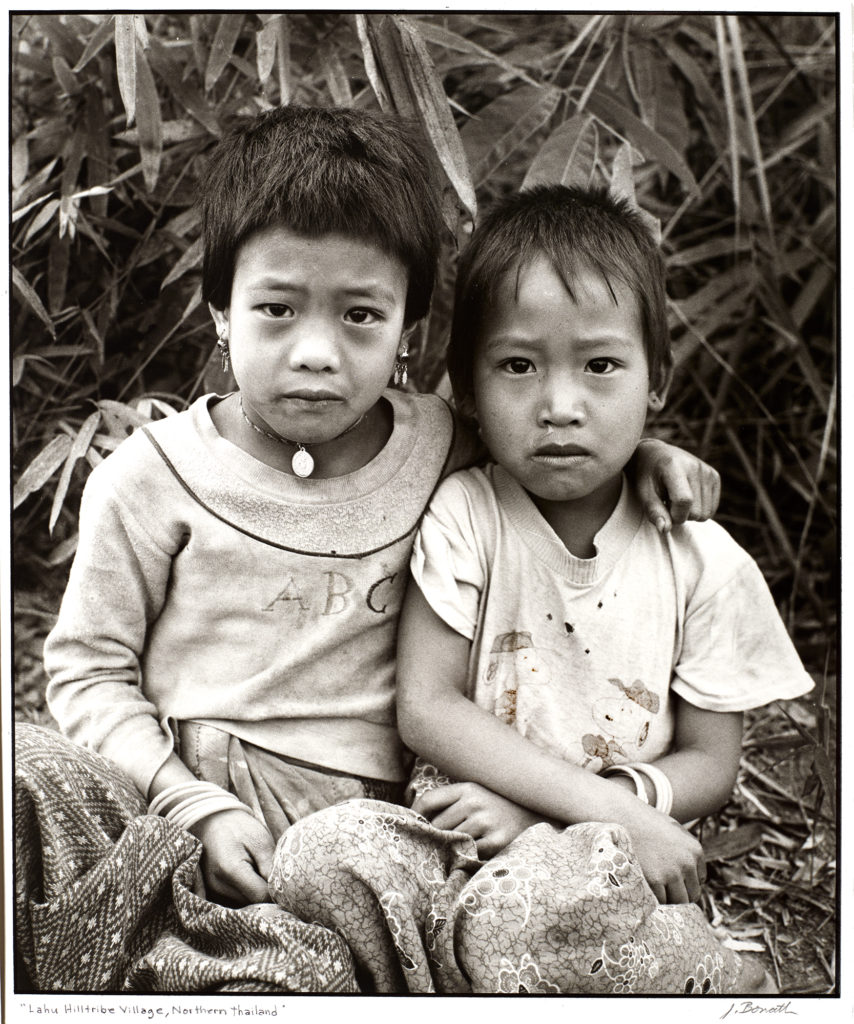
Although small groups like us were a regular occurrence, it was a special event for foreigners to come through. The children were fascinated with us, which made it easy for me to interact with my camera. In the end, I gave them some change in gratitude for posing, but with some guilt, as soon enough, they would learn to beg for money from the tourists. At this point in time, adventuresome travelers were charting these territories and the colorful locals were just learning the perks of tourism. By the end of our adventure we had hiked through many opium-poppy fields and a Jeep was waiting to take us along the dusting road back to Chiang Mai.
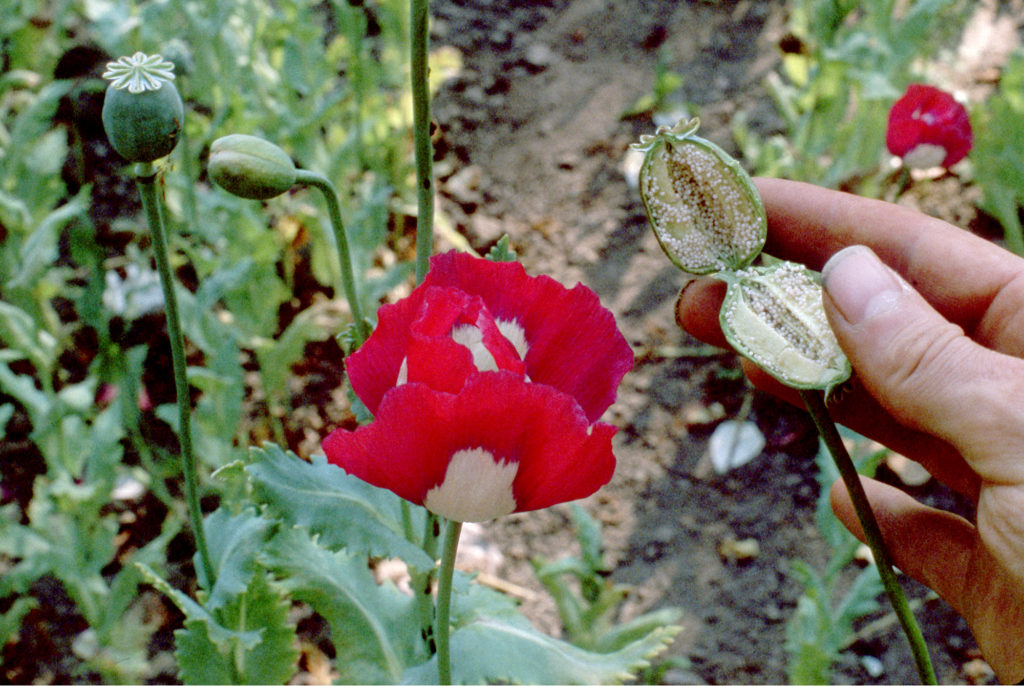
When I arrived back in Bangkok, I needed a respite from adventure. A sleepless night in the Bangkok hostel dormitory room with the fellow under me snoring all night like a mad lion in heat, and the noise and air pollution gave me plenty of incentive to move on as soon as possible. I met some travelers at the youth hostel who told of a paradise that was barely discovered at the tip of Thailand called Phuket. They described a beautiful blue lagoon that you could rent bungalows on the beach for a couple dollars a night (this was at a time before major hotels were built there). It sounded like bliss, so I headed down the long peninsula on an eleven-hour train ride to Phuket.
4
The nearly-empty train was a rickety ride with hard, wooden seats. The day was hot and all the train windows were wide open. A breeze rushed past my face as I viewed the scenery. After eating something from my backpack, I looked around for a trash can to throw my garbage. There wasn’t one in my car so I walked through to the next car and there was one towards the end of the car. After throwing my trash away, I decided to resettle in that car. Soon after, the conductor came through. He didn’t bother to check my ticket but gave me a big smile and noticed the full trash can. He unfastened the trash can, leaned over to an open window, and dumped the trash out as I watched it scatter onto the landscape.
In the same train car was a young couple from Italy who were backpacking travelers like myself. It was a long ride as we chatted and became fast friends. They were also headed to Phuket and we decided to travel together for a couple days. They had heard from a traveler in Bangkok of an undiscovered place halfway down the peninsula on the way to Phuket. The ride to Phuket was a long one, so taking an extra day to check out this intriguing spot sounded ideal. I never made it to Phuket, and considered never leaving the place we were about to discover.
We got off at the stop for Thap Sakae but had no idea where we were going. It was a bit like the search for El Dorado. After walking around the town, running into dead ends, asking locals who didn’t know what we were talking about, we eventually stumbled across what we were looking for.
When we finally found the place, we were greeted with great hospitality and enthusiasm by the owner. The bungalows were run by an eccentric and extroverted queen who lived to entertain and cook for his guests. He had grown up in this little town and had inherited the land from his family. Each morning, our host would be driven down to the village markets to select the makings for our daily meals. He would then spend each day cooking for his guests. These visual culinary wonders were laid out with the flair of a Roman feast. Thai dishes of fresh vegetables, fruit, and huge ocean catches of the day were common. He was indeed no businessman and spent more on us than he made off us. It was simply paradise. He wanted to get his business on the radar of travelers like us and would ask us for advice and give us his fliers to spread around.

To one side of the grounds lay the ocean. On the other side of the grounds were thatched-roofed bungalows built over a river, and each bungalow had a deck and was furnished with a hammock, some chairs, and a table. In the middle of the bungalow complex was a very large, open spaced, community structure with a thatched roof. This common house had a view of the ocean. It had a large salt-water aquarium on one end, a small library, lounging sofas, and in the middle, a giant banquet table where all our meals were served. A bungalow with all our meals cost $5 a day.


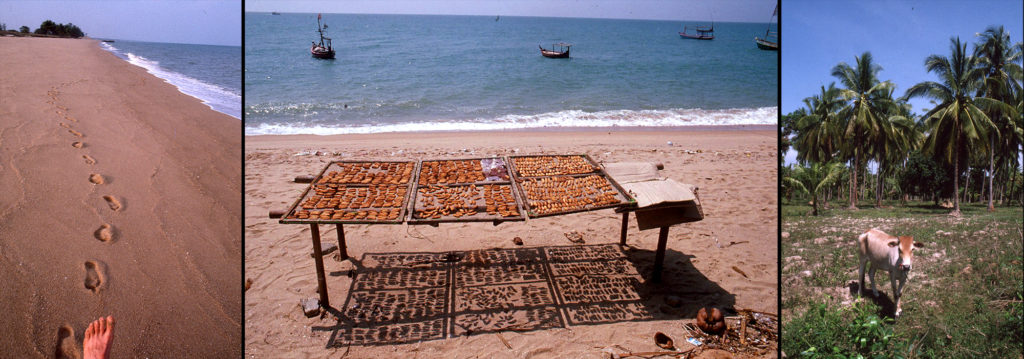
There was one British fellow who had been staying there for almost a year. Our host could not deal with driving and had a trade going with the British fellow to chauffeur him on errands for his keep. The British fellow was about ready to return to England, I was offered his position, and seriously considered it.
The only other guests were a mesmerizing couple in their early twenties. The couple was aloof. They were jet-setters in the process of endlessly traveling the world; their father was the wealthy magnet of an extensive hotel chain throughout Europe and Asia. Between travel hopping to such out-of-the-way places as Thap Sakae, they based themselves out of the penthouse suite at one of the family hotels when they could. They were identical male twins, lovers, and inseparable life partners. One had his golden blond hair cut short and dressed in fashionable, hip male attire. The other wore his golden hair very long and dressed in an effeminate, fashionable manor. I wanted to photograph them but when I got up the nerve to approach their bungalow the next day, they were gone. A common photographer’s unsung song, destined to live on in memory only.
One morning our host went to the morning market as usual, but this day there was a man at the market selling a spider monkey. It was love at first sight for our host. It was an impulse purchase; he had no idea how to take care of a monkey and lost interest by the time they got back home. He asked me if I would mind looking after his monkey as he didn’t know what to do with it. Liking the idea of taking on this charming little beast, I agreed. When I didn’t take my little ape buddy with me, he was tethered to my bungalow. He was quite a challenge at times as he wanted to start playing first thing at sunrise and would jump up and down on top of me to wake me up. Like a young child, he didn’t like it when I disciplined him and would try to bite me. But shortly after I was brought into his life, we bonded and he was a jolly buddy to hang out with most of the time.
I fell in love with this place, considered never leaving, and ended up staying for three weeks.

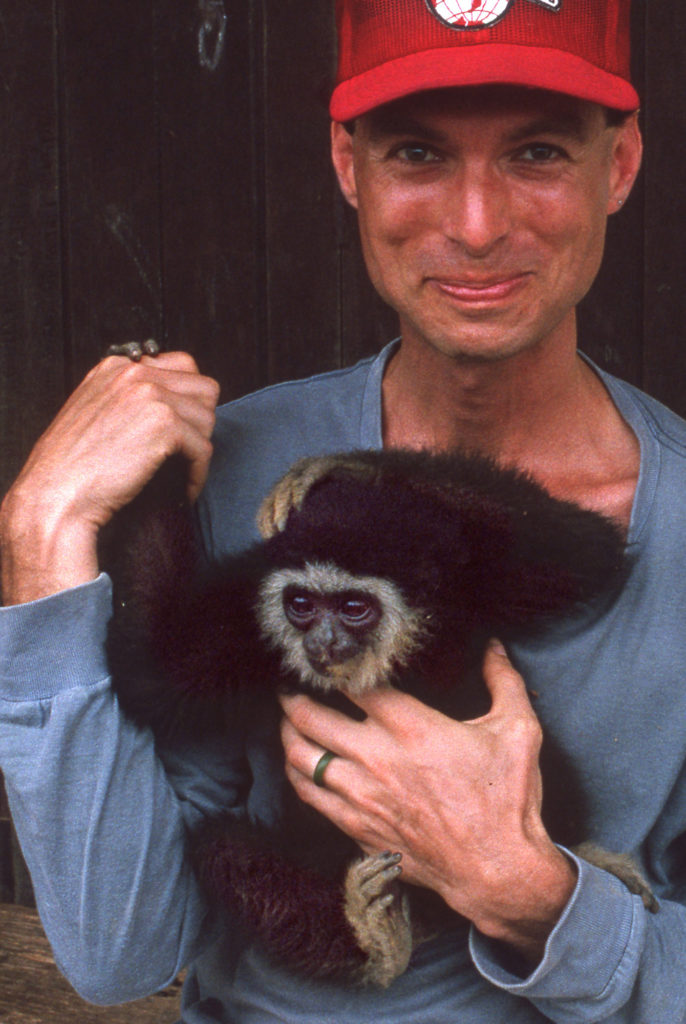
My favorite pastime is to beach comb endlessly down an ocean coastline, with the sound of gentle waves lapping in my ear, the feel of sand and foamy sea under my bare feet, all the while breathing the fresh smell of ion-charged air coming off the surf. I never know what treasures the sea will wash ashore to collect or photograph. One morning, I packed some food and headed down the beach for the day. I passed jungles, wastelands, abandoned huts, and many droopy-rabbit-eared cows. The landscape was much the same as I walked hour after hour down the hot beach stopping occasionally for a sip of water or to take some photographs. After three hours, I became weary. I was looking for some nice shade for a nap when all of a sudden, out of nowhere, I ran into an oasis… or was it a mirage? I literally could not believe my eyes.
There appeared, out of nowhere, to be a Maharajah’s palace courtyard at the beach’s edge. At the sand’s end was an intricate tile floor, completely free of sand before my bare feet walked upon it. The uninhabited court had no walls and the huge water fountain in the middle was very inviting. I was drawn to this mesmerizing water fountain as if in a trance. The fountain took the form of four life-sized, elephant heads connected together in the center. The elephant heads were covered in light blue mosaic tiles which appeared to be facing North, South, East, and West. Abundant water flowed from their elegant trunks into the large pool that surrounded them. I cupped my hands and let the cool water cascade over my palms for a moment before splashing some on my face as if being baptized by some magical holy water. It felt as if I had walked into a fairy tale. As this tale went, I was tired and laid down on the fountain’s ledge to rest. Spellbound, I listened to the water before me cascading out of the magical beast’s trunks. I closed my eyes, and began to drift off into a dream-like reverie.
As I lay there, I had the uncanny feeling that I was being watched. I cracked my eyes open and noticed someone hiding on the other side of the fountain staring at me with large deer-like eyes and an angelic smile beaming across his face. I sat up and smiled back, as he came out from behind the elephant head. He seemed just as mesmerized by me as I was of him. He continued to smile his muse-like smile in a state of naive wonder at my unusual appearance into his world. I had never met anyone like him before and I am sure the same was true for him. He was a young monk, wrapped in orange with a freshly shaven head. His gender appeared androgynous as he gracefully came over and sat next to my camera bag. We did not speak a common language, but communicated very efficiently in other ways. I let him take everything out of my camera bag as he studied each object with great interest and joy, playing with my camera, sunglasses, and trying on the sheepskin sherpa hat that I used to pad my camera with. Our relaxed and surreal “conversation” lasted quite some time as I shared my snack with him. His name was Bahn and mine, John, so that was easy. He was a child looking for something to do that afternoon when he discovered me sleeping on his fountain. I felt that he was the most innocent being I had ever met. He was void of fear or shyness, filled with a blissful joy that seemed to emanate from him. I was captivated by a feeling of familiarity with this being and somehow Bahn was on the same wavelength. I let myself be directed by this little elfin monk as he took possession of his private find.
After exploring all that I carried with me, Bahn gestured with his jubilant smile for me to come with him. Bahn appeared to be one of the happiest children that I had ever met. His existence was simple in materialistic ways, yet full of life. A breeze of clean, fresh ocean air wafted through the temple complex as he led me to his personal “house”. Instead of the usual small, depressing room in the orphanage-like monasteries in the cities, he lived in a small box on top of stilts, accessible by steep steps, like a small tree house. He motioned me to follow him as he climbed up and I followed him into his little hut.
Although this is not the four-headed elephant fountain as described in the monologue at Wat Namthawararam, it is an example of this common motif. This four-headed elephant is carved out of white marble and can be found in Bangkok.
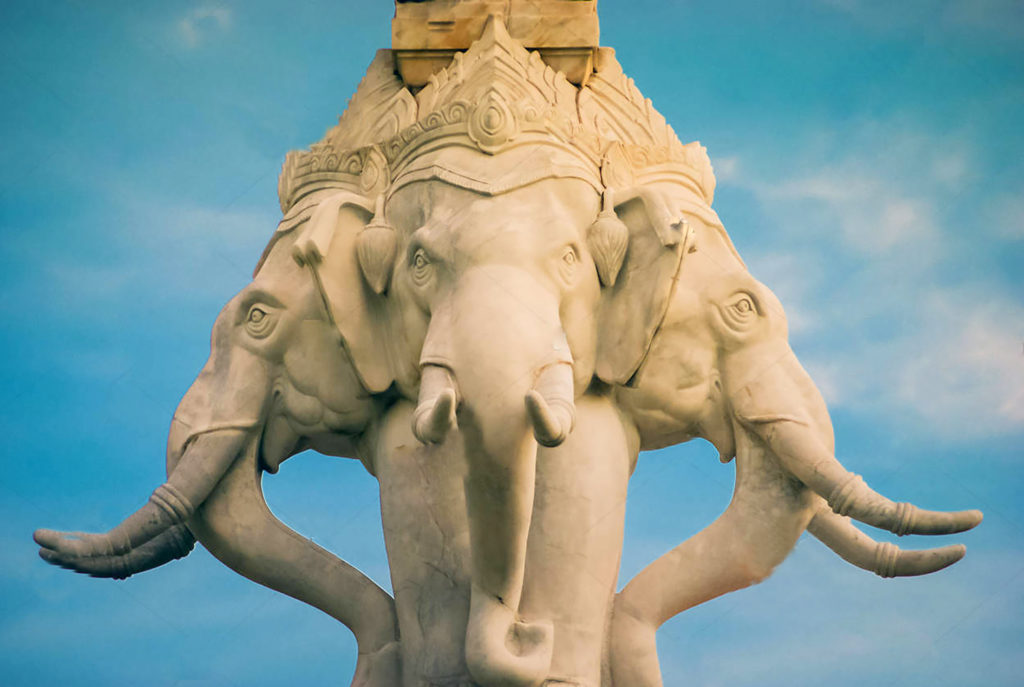
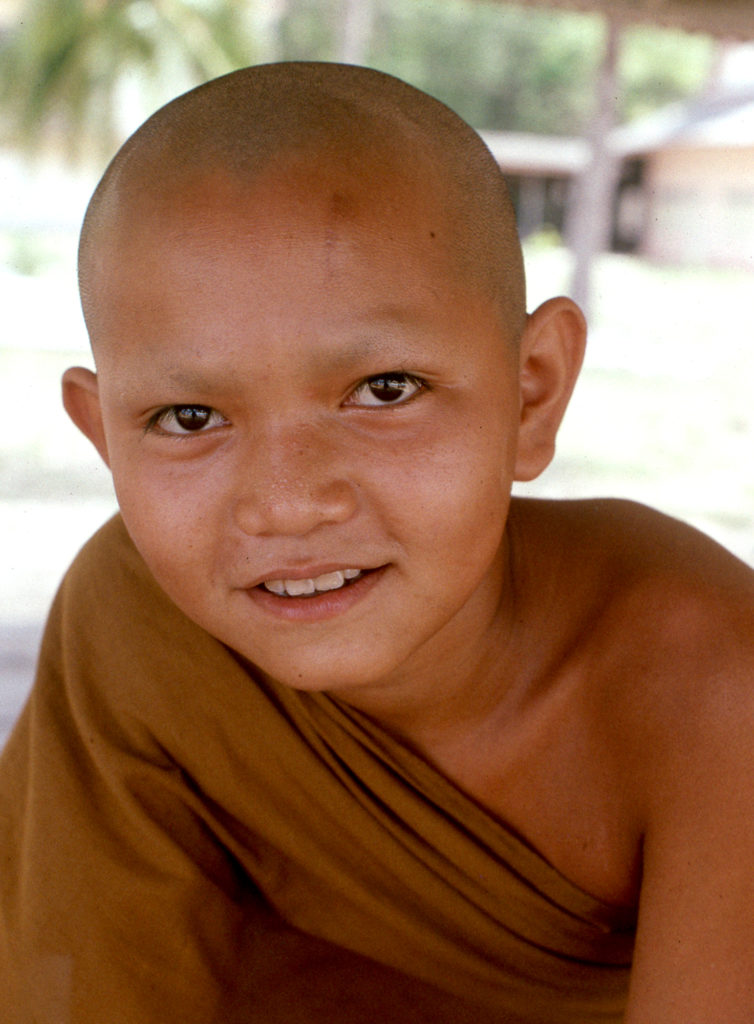

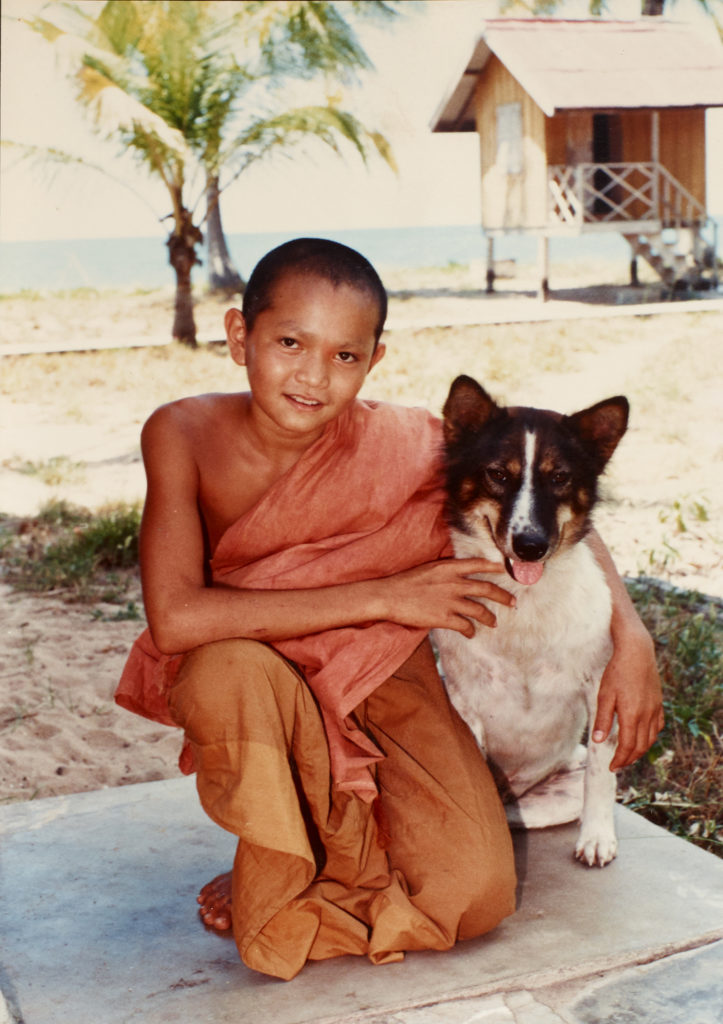
It was apparent to Bahn that I was exhausted. He rolled out a small sleeping mat of woven plastic braids, pointed to it, and put his hands to his cheek, gesturing me to lie down and take a nap. Spellbound, I laid on the mat and fell quickly asleep. I don’t know how long I was out but when I opened my eyes, there was Bahn sitting across from me, looking over me the whole time with a beaming smile on his face. I was in a dream I could not wake from. In the peaceful calm of his room, he began to show me everything he owned, sharing his life with me.
There was not much room for worldly possessions in Bahn’s little living box on stilts. Conversing in universal forms of communication, he shared it all beginning with his beautiful metal meal bowl that was laying against the wall. Then there was a small metal box wrapped in orange that housed his most personal objects. Inside were various articles, each wrapped in orange cloth. He unwrapped some little stone Buddhas and some metal ceremonial items and talismans. Next, with the greatest pride, he showed me a thick mail order catalog from America. It was a gun catalog with pictures of about every type of gun imaginable. As we paged through, he showed me his favorites. Lastly, he picked up a little photo album and handed it to me; it was like what you get back from the drugstore when they process a roll of film. These few things plus the plastic mat comprised all of Bahn’s worldly possessions.
As I flipped through photos of Bahn and the people in his life, I noticed that they were all men of varying ages, wrapped in the same orange cloth. The people in the pictures seemed to be gathered for a special event. When I flipped to the next page in the album… my heart stopped, I lost my breath, and for a moment time froze. There it was, a perfect deja vous in every detail. It was the manifestation of a portended dream verbatim. The camera’s perspective was in exact alignment to the composition of the image embedded in my psyche so long ago. At that moment, this snapshot and my life became the same and I was there, home. How could this be? Yet there it was.
The photo was taken from where I stood in the circle. Shoulder to shoulder, the men surrounded a reclining monk in the center, with hands folded across his abdomen. The color of orange resonated perfectly for the first time. (Each temple denotes its group with its own subtly distinct color of orange. The Tibetan orange always felt too dark and bright, but was the closest I had seen, up to this moment.) The faces in my image were generic and were in accord with the faces in the photo before me as they looked down with sorrow and love – it appeared in memory to be identical. Bahn’s love for this man, as well as all those standing around the prone body, was no less than that of apostles standing around the body of their beloved master. I surmised this man was Bahn’s teacher from the beginning of his life at this temple. With a feeling of complete awakening, I put the album down, gathered my things, and we began to head out.
As we descended the steps, we were met by Bahn’s two best friends and an older monk who had spotted us. Bahn’s two friends were excited to see me, as they laughed and chatted away. The older monk was silent, stern, wary of the possibility that I might be a foreign pedophile predator, and scolded Bahn for inviting me into his box. His suspicions were quickly put aside when I grabbed the opportunity for a photo opt and asked if I could photograph him. His ego was honored and his vibes were captured in the portrait. After taking some more photos of the boys, I promised to return and headed back up the coastline.
Later that week, I returned with some squirt guns for them. My little munchkins had a great time hamming it up for the camera with their new gifts.

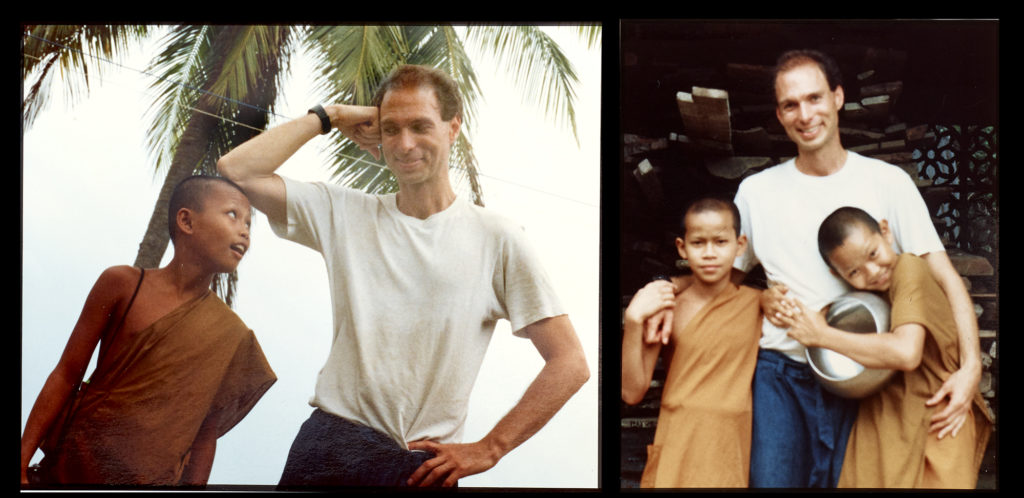
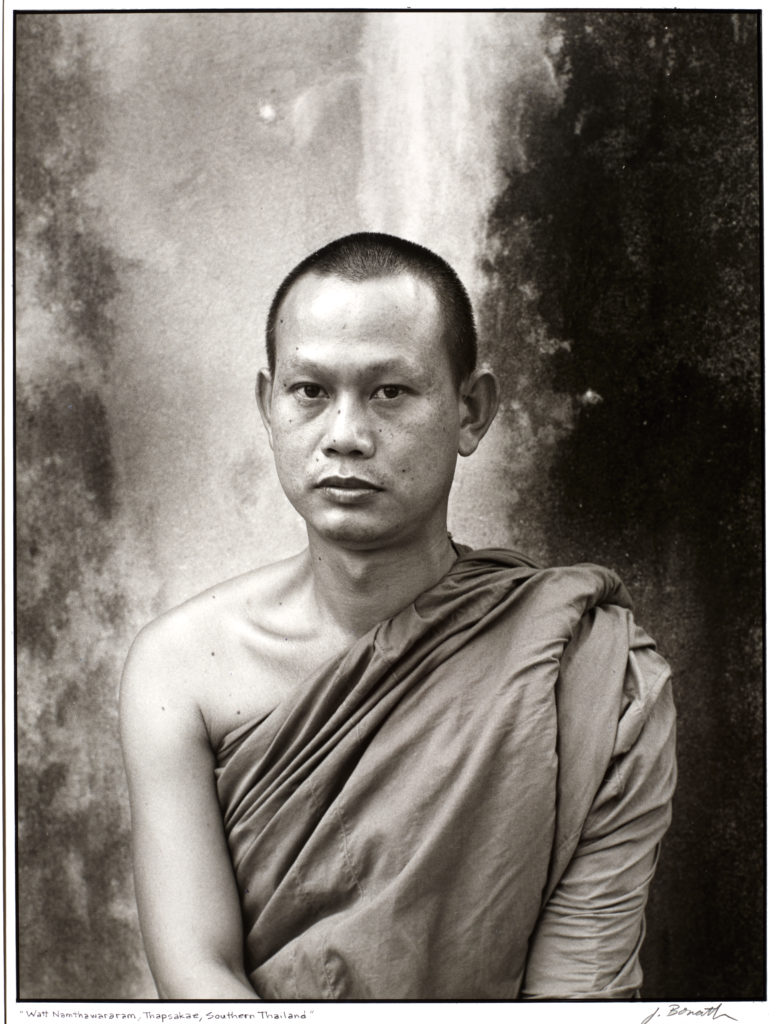
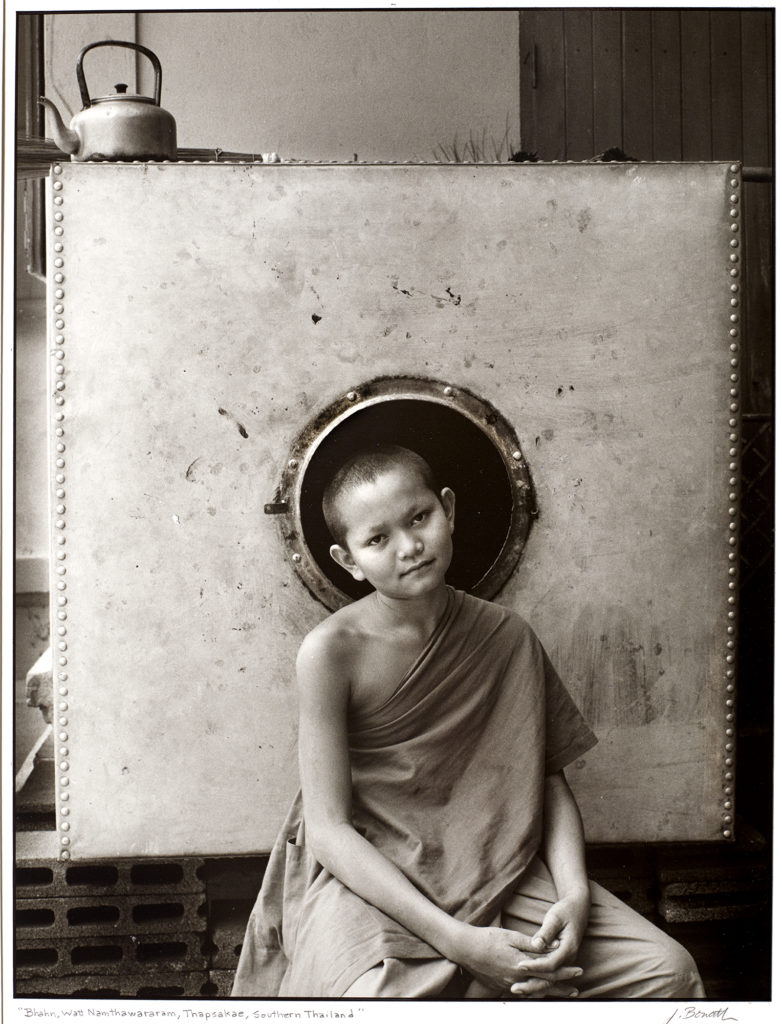
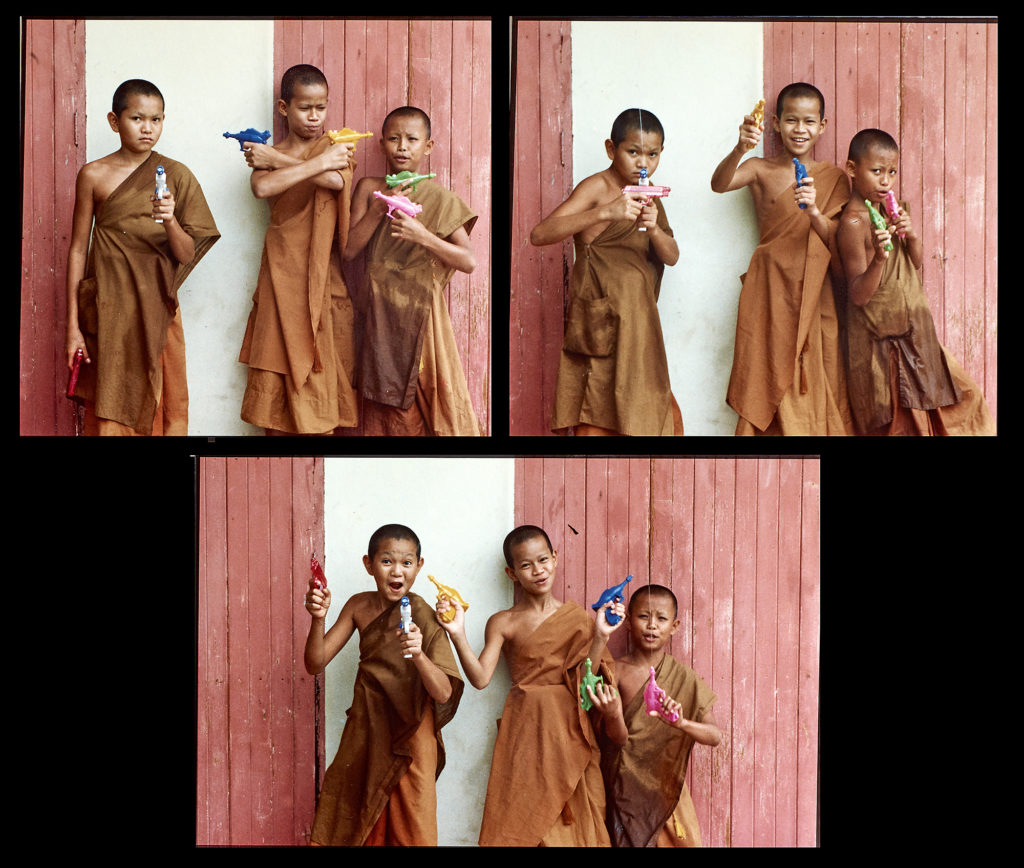
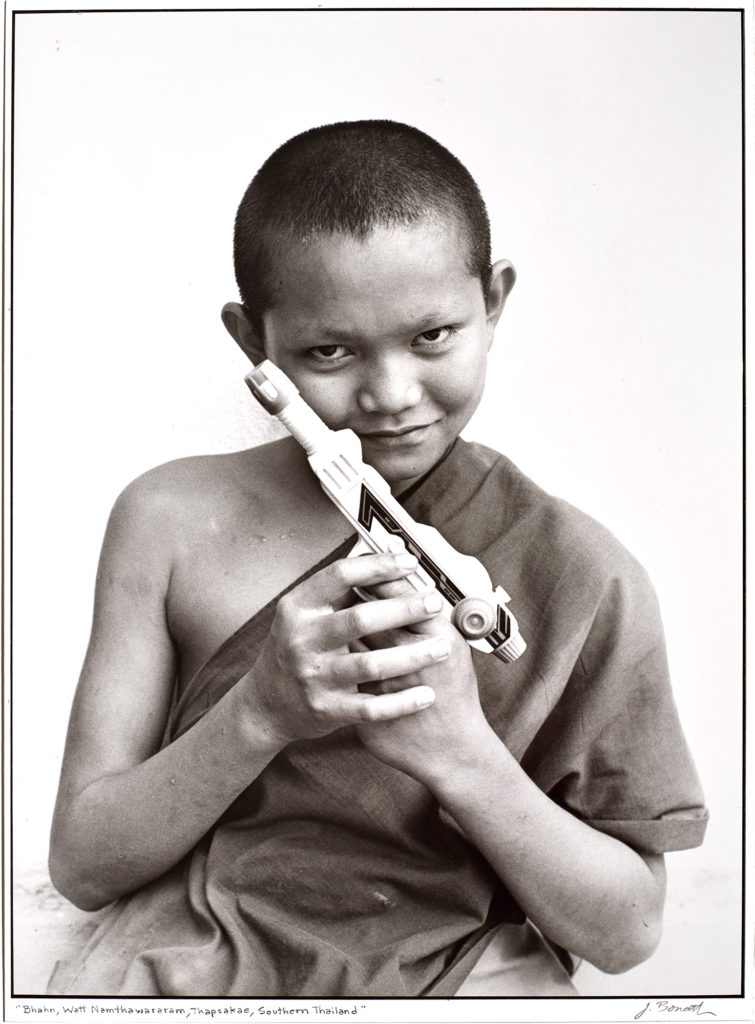

5
During my stay at the bungalows, I became friends with a Thai fellow named Sunti who tended the grounds and spoke some English. I watched him shimmy up the coconut trees each day to collect, cut, and keep the refrigerator stocked with fresh coconut water and then we would hang out and talk over breakfast.
Towards the end of my stay, there seemed to be something special in the air at the temples. I asked Sunti what was going on and he told me that there was to be a full lunar eclipse that night. He suggested we get together and watch it. He lived down the beach aways and we agreed to start walking in each other’s direction at dusk and meet midway. I grabbed a beach towel and headed down the shore at sunset with the full moon hanging in all its glory over the ocean. The surf was quiet, with a stillness in the air that was mixed with an edge of excitement as I pitched my towel and gazed out over the sea. Before long, I could see Sunti’s small silhouette growing larger as he waved, arriving from the opposite direction. Dusk was upon us as the last rays of the sun disappeared and were replaced by the full moon illuminating the landscape with a bright bluish light and deep black shadows.
As we lay in wait for the eclipse, Sunti spoke of the Thai-animist-Hindu beliefs surrounding the event. The Thai tales mostly consider an eclipse bad luck with these kinds of superstitious ideas very much alive in contemporary thinking. Accordingly, an eclipse takes place when the angry black God Rahu swallows the moon. The only way to prevent disaster is to scare Rahu away or placate him with offerings. When an eclipse begins, people will commence clashing gongs and exploding firecrackers to frighten Rahu away.
In short, the legend goes that some Hindu gods created an elixir of immortality. The gods promised to share the elixir with the demons, who helped create it. But the gods enchanted the demons and stole their portion. When the demon Rahu, god of darkness, pilfered a swig of the elixir, the sun and moon ratted on him to the gods. He was then caught and the gods cut off his head in punishment. Fortunately for Rahu, he was immortal so that didn’t kill him. He was quite angry at the sun and moon for betraying him and chased them down. Every so often he catches up to one of them and swallows it, but because he is just a severed head, the sun or the moon slips back out through his disconnected neck. Nonetheless, Rahu continues his pursuit indefinitely through time.
Belief in the supernatural world of spirits, gods, and demons are intermixed with the majority of Thai’s religious beliefs. These superstitions are a part of many people’s core values and looking to mystical methods to sort out problems is not uncommon. Some Thai people believe that bad luck always comes with an eclipse, so major changes and big losses are inevitable and therefore visits to temples with statues of Rahu become popular before such events.
In the distance we could hear the clamoring of temple bells mixed with the detonation of firecrackers as the Earth’s shadow began its journey across the face of the moon. The eclipse became darker and darker as Rahu began to swallow the moon. When the moon was covered fully in shadow, the darkness was so complete that I could not even see the hand in front of my face. Then the corona on one side of the eclipse began to get brighter and I could begin to make out Sunti’s silhouette once again.
He said, “Let’s go for a swim in the ocean.”
It was still dark and the ocean was pitch black, like some liquid void with an unearthly planetary body hanging over it. Nothing in the landscape felt familiar. The idea of swimming in the sea at night had a certain magic about it making the warm tropical sea feel welcoming. Perhaps because you can see less, your sensation of touch is heightened. The warm draw into the dark water was simultaneously matched with the possibility of danger of what might be lurking beneath the surface. The opening scene from “Jaws” came to mind, increasing the feeling of vulnerability. Jungian psychology describes immersion in such waters as these, as a descent into the dark world of the subconscious. However, the day had been hot and a short dip sounded refreshing, so I followed Sunti’s lead and abandoned myself to the lure of an unearthly moon into another realm. The gentle sound of the waves lapping the shore was like the beckoning whisper of muses calling to the ocean’s darkness. With the sense of vision diminished, the smell of the fresh surf coming from the water guided me forward. In a trance I could feel the warm water bathing my feet as I headed towards the dark waters in a rite of spiritual rebirth. As the edge of the foreign moon began to wax brighter in the starry sky I lost connection to any earthly plane. What I was about to behold would be one of the most magical moments of wonder in my life.
Slowly I waded into the sultry sea. It appeared as if the water was beginning to glow around my legs as it slowly rose with my stride. Every movement my body made left a trail of temporary, twinkling, swirling, neon-blue moonlight dust in its wake. When we were waist deep, Sunti began to splash me wildly with shouts of laughter and screams of joy. In doing so, the water lit up and gave off a brilliant blue light that illuminated both of us completely. I could not believe my eyes and began to splash back, not knowing what to expect. As I did, the water around my hands and in the air lit everything around it with an enchanting blue light. The form a splash took was pure light itself. How on earth had I stumbled into this beguiling time and place? Once again, my only reality was a vivid dream, and for the moment, we were in an alternative universe. We danced and painted with the light under a foreign moon, the ocean black and expansive made of wizard’s water that radiated blue light. Stars swirled above in the midnight sky as well as below in the bioluminescent water.
By the time the full moon lit the night once again, we were spellbound, said “good night”, and headed back up the beach in our opposite directions.
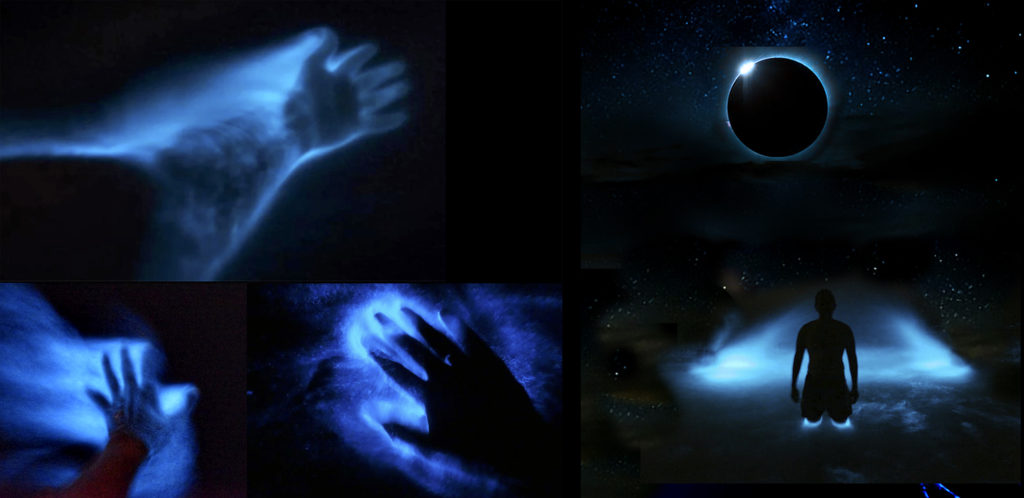
As I headed down the moonlit beach, the world had been transformed. It was not the same beach I had walked down that evening. No sooner would my footsteps be recorded in the sand, than I would watch as they were washed away. I did not need to see them disappear to know the pattern; each new footstep replaced the last and only went in one direction. Life in that moment was timeless, without wounds, drifting, and eternal. The distances I traveled were within myself. Life ahead was, as yet, a blank canvas, waiting to be painted back in Japan.
The next morning, I delivered my ape friend to his future destiny and boarded a train back up the peninsula and spent a relatively quiet night at the Bangkok youth hostel. Early the following morning, toxic fumes were already thick in the air as I hailed a taxi to the airport. There was no surprise when the taxi driver offered me sex with a “young, beautiful Thai girl” on the way out. At that point, I just laughed and said I would be sure to miss the only flight back to Japan that day. When I arrived at the relative quiet and order of the airport, it was with a wave of relief that I shed the sensory overload of Bangkok, caught the flight back to Kyoto, and once again, stepped into the unknown that awaited.
Epilogue
Although I have no need to dwell on the idea of reincarnation, I have no reason to deny it either. We are not only connected to but a product of history. Rebirth is a process that takes place on an imperceptible level each day. If past lives do occur, they simply are a connection between the past, present, and future – the nature of eternal time which our lives pass through so quickly.
After setting up a new life in Tanabe, Japan, my colored snapshots of orange robed monks hung on my living room wall. I often pondered that corner, waiting for some insight to help me understand what had taken place. An epiphany never came, but the photos of my brothers from another time and place, reminded me of a human family that I am a part of and that is a part of me.
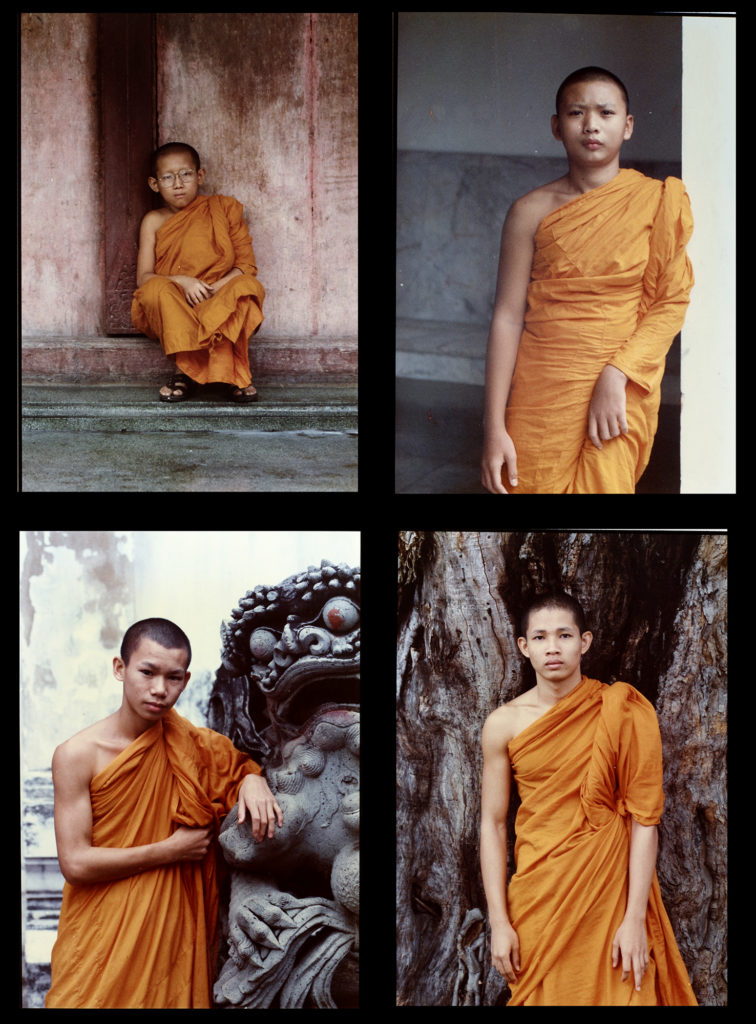
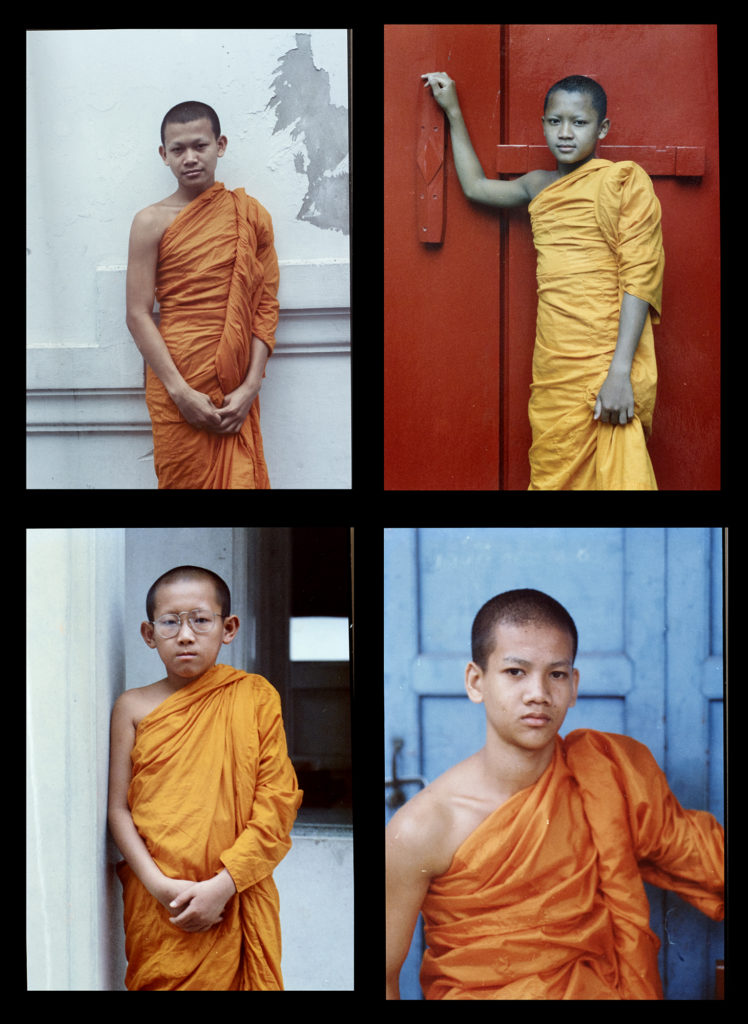

With my meager Japanese language skills and life in an area scarce of foreign visitors, I made new friends quickly. One new comrade became my photographic benefactor and set up a darkroom for us to share at his house. When I finished developing the film from Thailand and making prints, I sent the boys a set. In return, Bahn sent this letter and gift to me.
This memorial pendant is a bronze relief of Bahn’s deceased teacher from the funerary photo. Bahn explained in pictures how it works. If I wear it, it will bring me good fortune and protect me from harm. If I am not wearing it, I will be vulnerable to harm. I put my hands together in “gasho” gesture, bowed slightly to the man in the pendant, thanked him for looking over me, and wondered if Bahn were not, perhaps, just for grins, the reincarnation of my teacher from a past life.
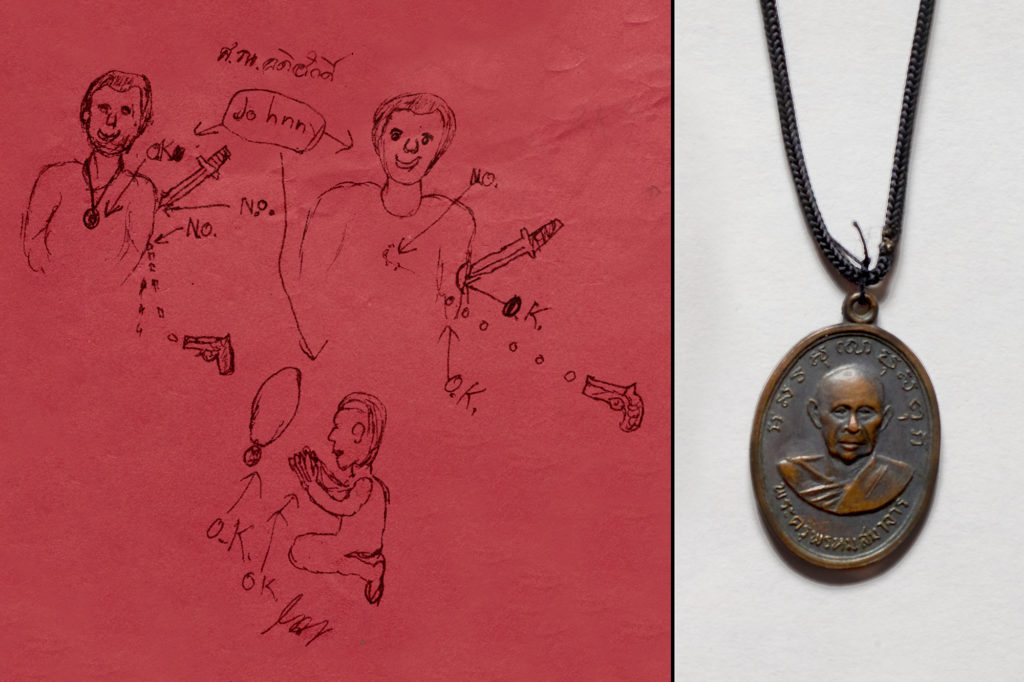
I have never been able to find someone to translate Bahn’s letter. After these many years, if anyone out there can offer a translation, it would be a thrill to finally be able to read it. If someone reading this blog can do this, or knows someone who can, please leave a translation in the comment box at the end of this blog – with gratitude. John
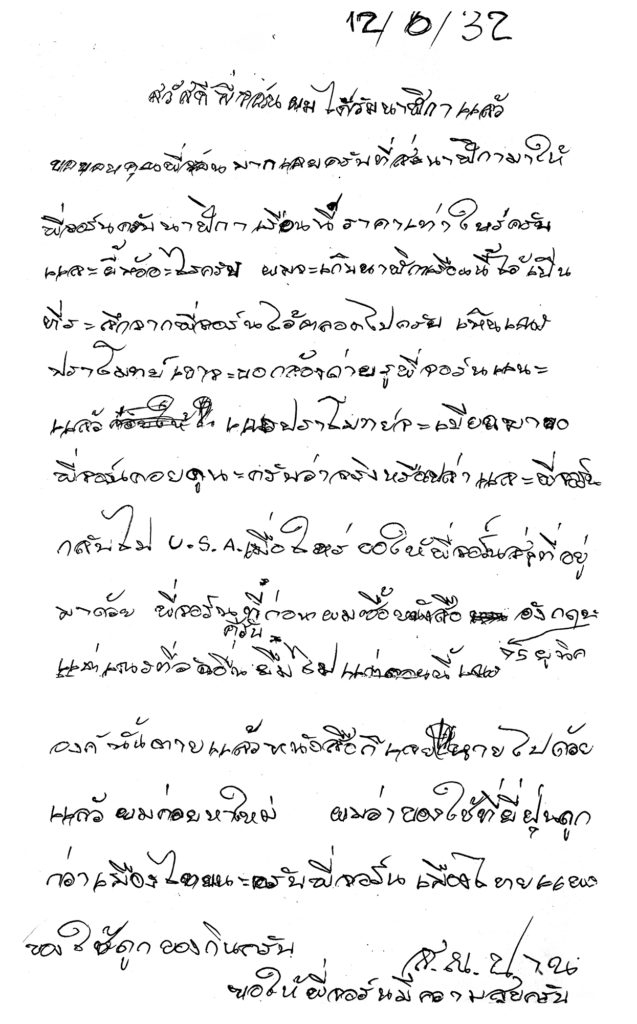


Linda Wyer
John, your story drew me in immediately. You have had quite the adventurous and thrilling life! I am looking forward to seeing you in September.
Doug Wyer
Thanks for sharing your well-written adventure. What an experience you had!
David Keener
Beautiful, John. Thanks for sharing.
Pamela Davis
I have a good friend in Denver who is a past life regression therapist. Mash and I have done a lot of work with her. She has written several books. We are in her 2 latest books. Lee Mitchell is her name. Crystalsoulpath.com You would enjoy a past life regression session with her I am sure. I believe you were indeed a monk in one of your past lives. You are definitely an empath.
This blog/ story was very easily read and well written. I would say you have mastered your writing art as well.
Sarah Weiss
Woke up to your blog this morning and immediately opened it. I loved reading about this journey. It was great connecting through your memoir. Just as you said, some stories never see the light of day and some do. Thank you for letting this one see the light.
Arlette Steinberger
Thank you again for your engaging blog. What an amazing experience. We were in Chang Mai in 1999. Reading your blog brought back wonderful memories of rafting the river and riding the elephants. Fortunately we did not encounter rapids and we chose to ride in the basket. At the time we went, we were able to visit the hill tribes via paved road but your visit was much more genuine than ours. What an incredible adventure you had!!! I hope you are in good health.
Chris Leatherwood
John, your story brought up many memories of my own journeys in Asia, 1981-1994. The world was such a different place then, especially pre-internet, when time and one’s experience unfolded at a much more human pace. It seems that we could really live our reality in the moment and absorb it in a way that’s hard to do now with our (my) attention being drawn in several directions at the same time. Maybe that’s why you have such vivid and detailed memories! Anyway, really loved reading it!
Terry
I read your story with great interest. For one thing, I read the same book on Yoga in 1958, when I was 13. I found it in the University of Denver library, where I was looking for something to write about for a social studies assignment. You describe the Indian yogi so well — and the cleansing of the sinuses! — I know that it had to be the same book.The book inspired me to try to meditate and do yoga poses, long before there were meditation training programs or yoga classes. 25 years later I finally got to Asia, to Nepal, and had an experience somewhat like yours. One morning in a monastery, I had an overwhelming conviction that I knew the melody the adolescent boy-monks were singing. At the same time, I had never heard the melody before. Like you, I don’t know if there is reincarnation, but I am convinced that we human beings are deeply connected with each other in ways we cannot understand with our science or common sense. Thank you for sharing the experiences you had in Thailand.
Rene O'Connell
Such a thrilling read and what an adventure. I remember some of the historical events you describe but managed to bury it away until now. Too often we take our blessings and fortune for granted. Oh and, loved seeing you as a young man!!
Jim Moore
John, thank you for sharing your perspective and art with all of us.
This piece is both entertaining and thought-provoking. Especially your observation that
‘Life in that moment was timeless, without wounds, drifting, and eternal. The distances I traveled were within myself. Life ahead was, as yet, a blank canvas, waiting to be painted …’ . I too have treasured such moments and look forward to more – both mine and yours.
Johnny(John)Pocernich
WOW !!! All of your stories were fabulous but I think this one got the prize. Your life and adventures are over the moon and you have to be proud of where you’ve been and how life has taken you through it. I was in Bangkok and upper Thailand 20 years ago but nothing like what you experienced. I even started crying at the end with the young boys and the joy you brought them and the piece to your past.
Thank you once again for your incredible life stories. You should do the book on John Bonath.
Mary Pridgen
A fascinating read! I forwarded the letter to my step-mom, Vandy, who is Cambodian and spent time in a Thai refugee camp as a child. I don’t know if her native Khmer is written with the same characters but she does speak some Thai and I thought it might be worth a try. I’ll let you know what she says.
Mike Holtby
John, I do know someone from Thailand who may be able to translate your letter. I will send it to him. I also was fascinated with the Buddhist novitiates, monks & nuns and have many photos of them in Thailand, Laos, Vietnam, Cambodia, and Myanmar. Your story brought back many memories for me as well, although my trips weren’t as rugged, extended and remote as yours – without monkey pets!
Sue Hunt
John, I am speechless. This blog was such an amazing read. The evolution of the story is long but scintillates from one episode to the next in such a natural way. I was so engrossed in each chapter that when finished, I could hardly remember the earlier ones. It is beautifully written and each experience captured so artfully. I have never traveled like this and yet I felt like I was living every moment. I can’t believe you traveled to all these obscure places so spontaneously and freely. The photos of you and the elephant, the monkey and the adorable young monks were so fun. What an intriguing insight into who you are as spirit and your life journey. I absolutely believe you were drawn to these people and placed by your past life memories and that the dimensions crossed for you connect and remember it on a soul level. Love, love, loved it! Thank you for sharing it with us.
Dan
John, I wasn’t expecting a story from Asia and really enjoyed reading about your adventures. I should have guessed since you lived in Japan. Thank you for the stories.